HMH Algebra 2 Volume 1 1st Edition Module 5 Chapter 5 Polynomial Functions
Page 249 Problem 1 Answer
It is given a polynomial in intercept form. It is required to explain that how do you sketch the graph of a polynomial in intercept form.
To sketch a graph of a polynomial, find the intercept then check the symmetry.
Use the multiplicities of the zeros to determine the behaviour of the polynomial at the $x$ intercepts.Determine the end behaviour by examining the leading term.
Use the behaviour and the behaviour at the intercept to sketch the graph.
The explanation to sketch the graph of a polynomial in intercept form is to find the intercept then check the symmetry.
Use the multiplicities of the zeros to determine the behaviour of the polynomial at the $x$ intercepts.
Determine the end behaviour by examining the leading term . Use the behaviour and the behaviour at the intercept to sketch the graph.
Page 249 Problem 2 Answer
The following functions are given, f(x)=x,
f(x)=x2,
f(x)=x3,
f(x)=x4 ,
f(x)=x5, and
f(x)=x6.
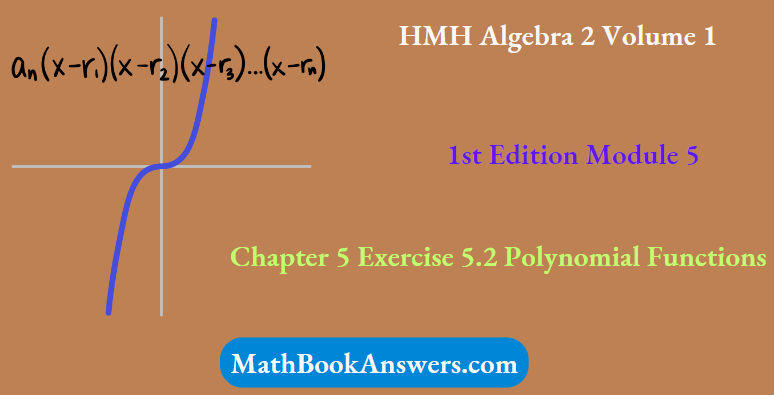
It is required to draw the graph of each function to determine the domain, range and end behavior of the functions.
To find the required answer draw the graph using the graphing calculator and analyze it to determine domain, range and end behavior and make a table.
Graph all the functions using a graphing calculator.
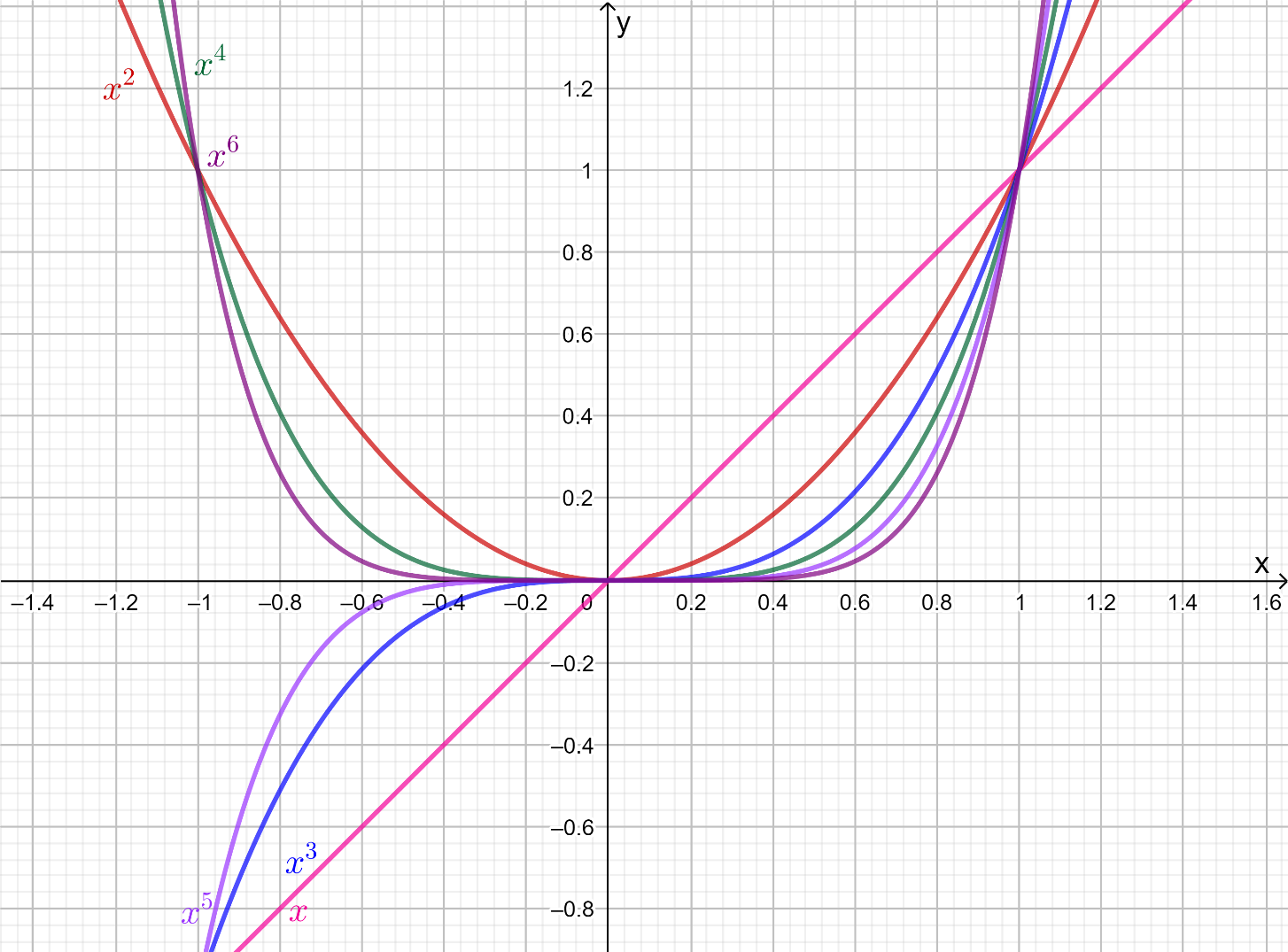
Observe the graph and complete the table filling the domain, rang and end behavior of the given functions.

The graph of all the function is given below.

The complete table is as follows.
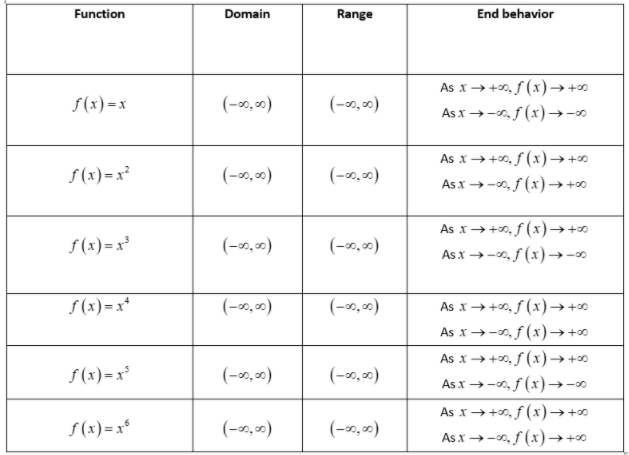
HMH Algebra 2 Volume 1 Module 5 Chapter 5 Exercise 5.2 Solutions
HMH Algebra 2 Volume 1 1st Edition Module 5 Chapter 5 Exercise 5.2 Polynomial Functions Page 249 Problem 3 Answer
The following functions are given, f(x)=−x,
f(x)=−x2,
f(x)=−x3 ,
f(x)=−x4 ,
f(x)=−x5and
f(x)=−x6 .
It is required to draw the graph of each function to determine the domain, range, and end behavior of the functions.
To find the required answer draw the graph using the graphing calculator and analyze it to determine domain, range, and end behavior and make a table.
Graph all the functions using a graphing calculator.
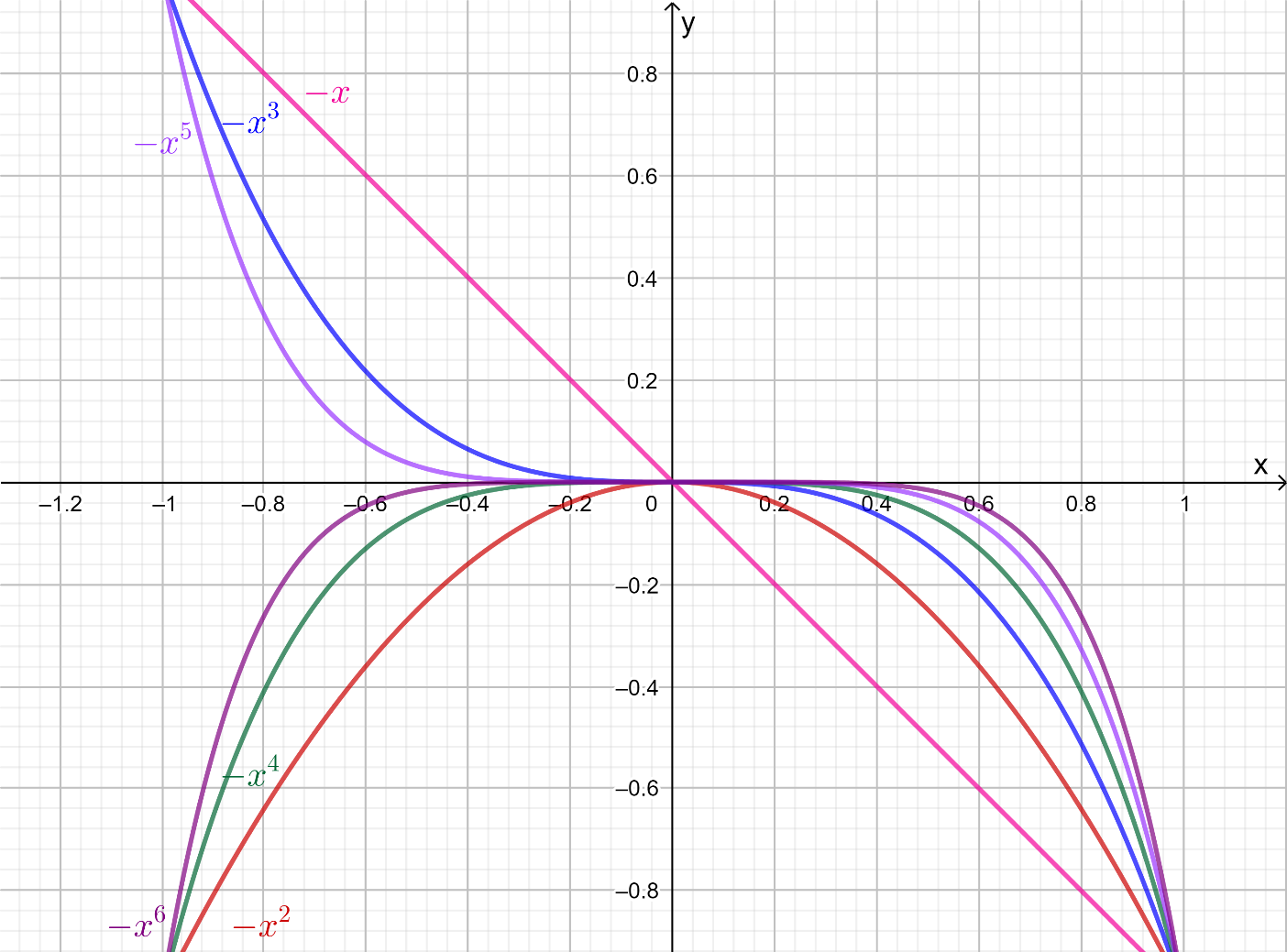
Observe the graph and complete the table filling the domain, rang, and end behavior of the given functions.

The graph of the functions is as follows.
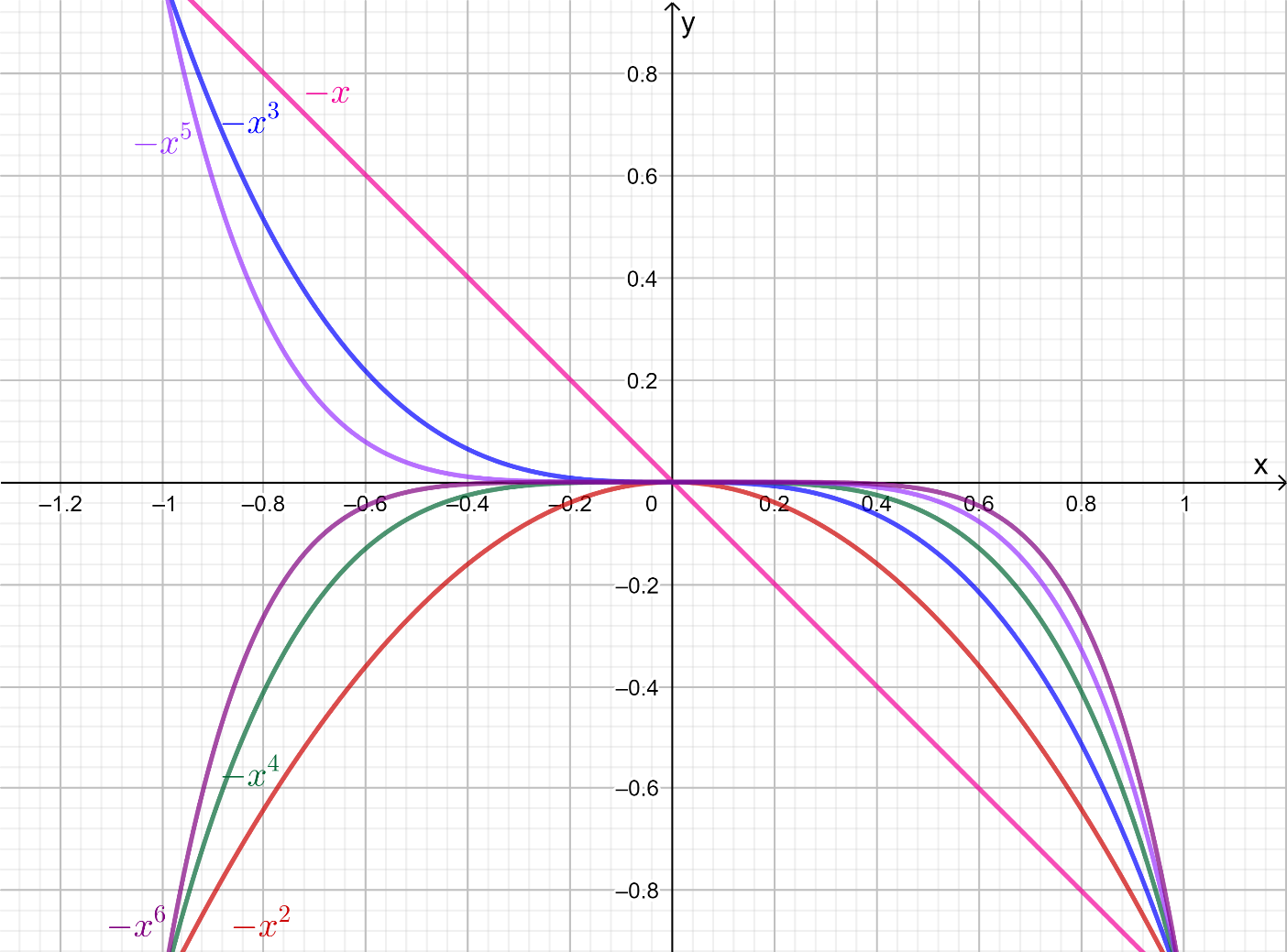
The complete table is as follow.
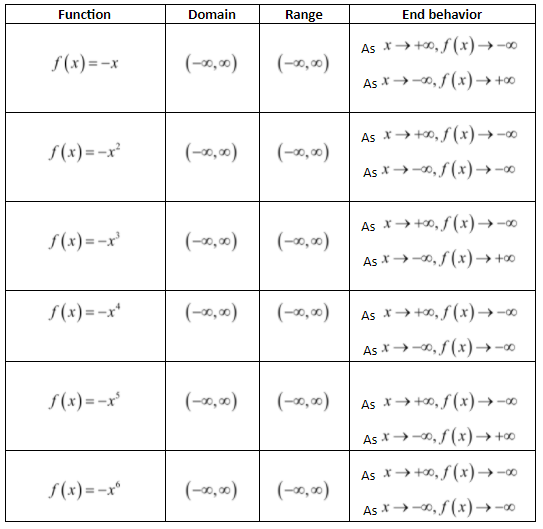
Page 250 Problem 4 Answer
It is given that two functions,f(x)=xn, f(x)=−xn where n is positive whole number.
It is required to generalize the result of this explore between these two given functions.
To generalize the result, substitute n with some positive whole number for both the function then analyse the result to get the general relation between them.
For the function f(x)=xn.
Substitute n with some positive whole number.
For n=1,
f(x)=x1
=x
For n=2,
f(x)=x2
For n=3
f(x)=x3
For the function f(x)=−xn.
Substitute n with some positive whole number.
For n=1,
f(x)=−x1
=−x
For n=2,
f(x)=−x2
For n=3,
f(x)=−x3
Now, compare the obtained result of both the function’s for n=1,2,3.
The relation between f(x)=xn and
f(x)=−xn is
f(x)=−f(x).
The generalize result of this explore between these two given function f(x)=−xn and f(x)=−f(x) is f(x)=−f(x).
Page 252 Problem 5 Answer
It is required to determine whether the graph of a polynomial function in intercept form crosses the x-axis or is tangent to it at an x−intercept.
The graph of p(x)=a(x−x1)(x−x2)…(x−xn) has x1,x2,…, and xn as its x-intercepts.
Hence, it is called intercept form.In equation p(x)=a(x−x1)(x−x2)…(x−xn) if x1,x2,…, and xn has non zero value imply function will cross x- axis, but if variable is 0, then this implies that the point is tangent to it at an x- intercept.
From equation p(x)=a(x−x1)(x−x2)…(x−xn) it can be determined whether the graph of a polynomial function in intercept form crosses the x- axis or is tangent to it at an x- intercept.
HMH Algebra 2 Volume 1 1st Edition Module 5 Chapter 5 Exercise 5.2 Polynomial Functions Page 252 Problem 6 Answer
It is required to find how the graph of the function changes when a factor of−1 is introduced.Consider the function f(x)=x4.
When a factor of−1 is introduced, it becomes f(x)=−x4.
Plot the graph f(x)=−x4, further observe the graph.
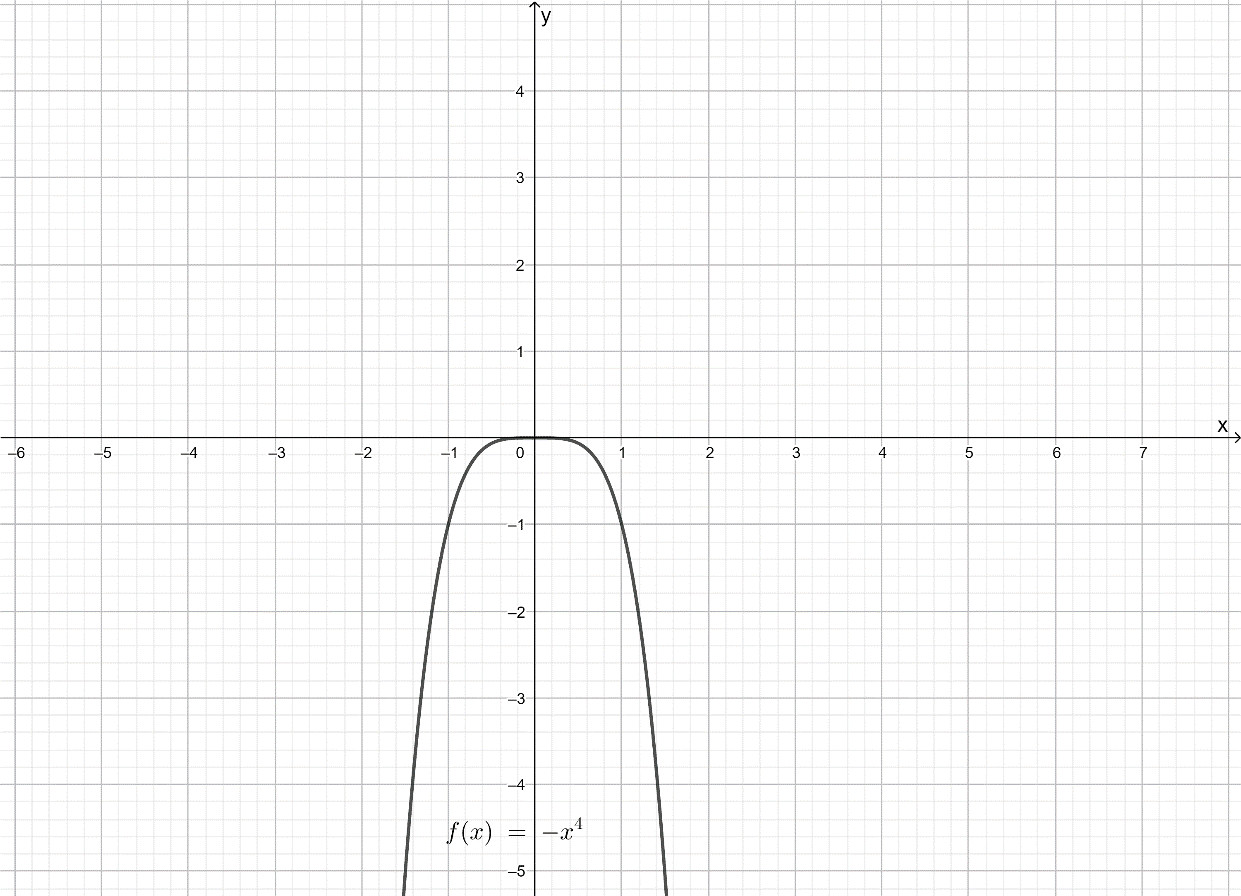
It can be observed that there is one distinct factor which is 0.
Further, there are no x- intercepts, as graph turn at point (0,0).
So, the graph is tangent to x- axis at x- intercepts: (0,0) and has only one turning point.
There is one global maximum value at(0,0) and global minimum none.
Therefore, the graph becomes a reflection of the its positive function.
When a factor of −1 is introduced in any function, the graph of the new function is symmetric to the previous one. Also, it is symmetric. The attributes remain the same.
Page 253 Problem 7 Answer
It is given equation f(x)=−(x−4)(x−1)(x+1)(x+2)
It is required to sketch the graph of the polynomial function.
First identify the end behavior of the graph. Then, find its x-intercepts. Now, identify the nature of the graph and draw the graph.
Identify the end behavior of the function, f(x)=−(x−4)(x−1)(x+1)(x+2).
As x tends to +∞, then f(x) tends to −∞.
As x tends to −∞, then f(x) tends to −∞.
Identify the x- intercept of graph. Then, use the sign of f(x) on the intervals determined by the x- intercept to find where the graph is above the x- axis and where It’s below the x- axis.
The x- intercept are,x=4,x=1,x=−1, and x=−2.
Tabulate the data and find the nature of f(x) according to each term.
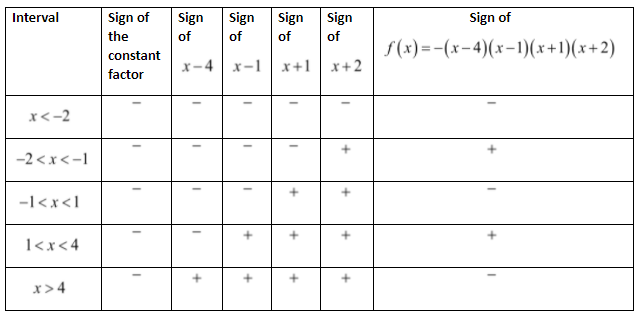
Plot the graph.
The graph of f(x) is above the x- axis on the intervals −2<x<−1 and 1<x<4.
It’s below the x- axis on the intervals x<−2, −1<x<1, and x>4.
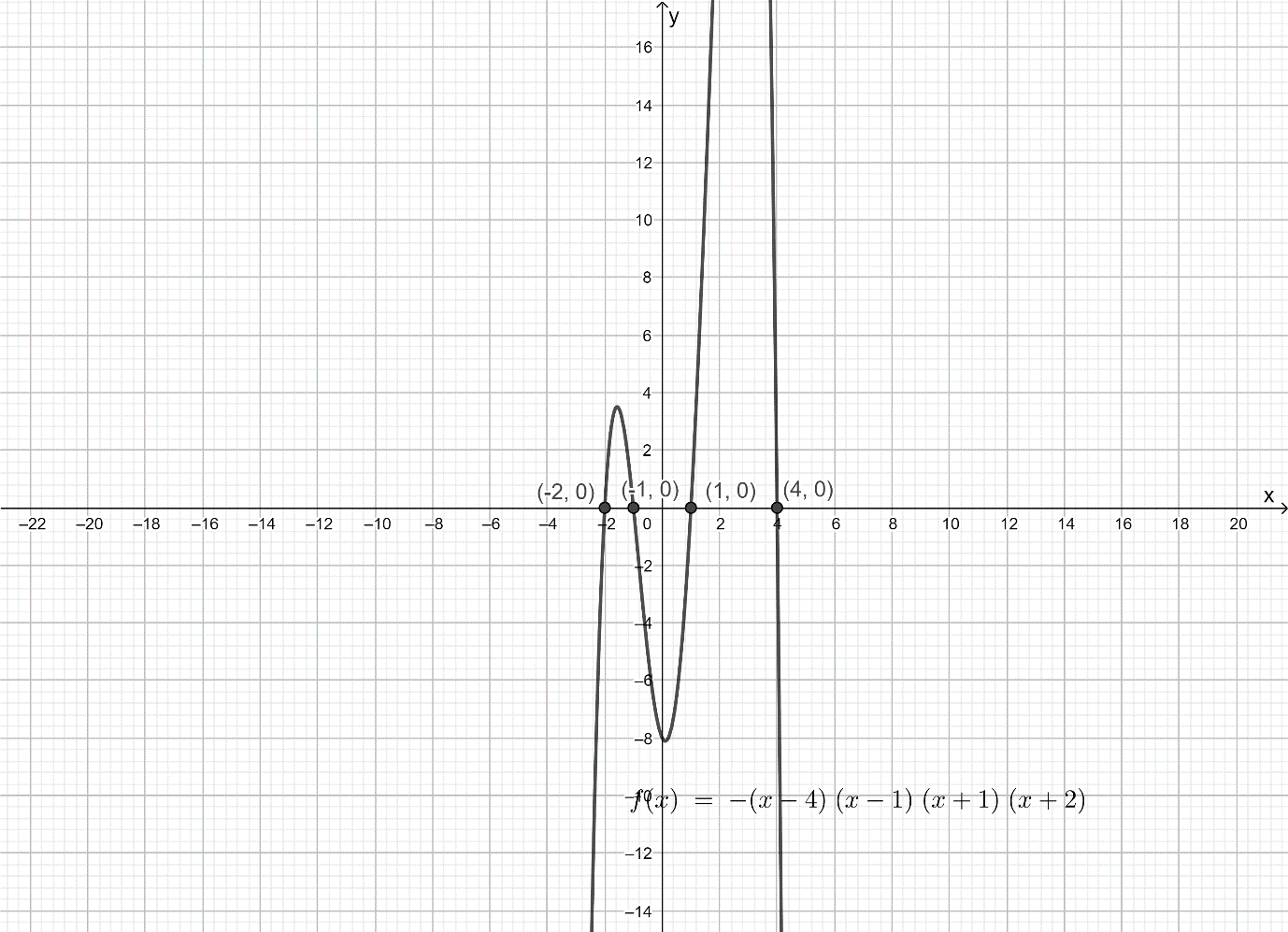
The sketch of the graph of f(x)=−(x−4)(x−1)(x+1)(x+2) is given below.
HMH Algebra 2 Volume 1 1st Edition Module 5 Chapter 5 Exercise 5.2 Polynomial Functions Page 255 Problem 8 Answer
It is given that f(x)=−x2(x−4).
It is required to sketch the graph of the polynomial function.
First, identify the end behavior of the graph. Then, find its x-intercepts. Now, identify the nature of the graph and draw the graph.
Identify the end behavior of the function, f(x)=−x2(x−4).
As x tends to +∞, then f(x) tends to−∞.
As x tends to −∞, then f(x) tends to +∞.
Identify the x- intercept of graph. Then, use the sign of f(x) on the intervals determined by the x- intercept to find where the graph is above the x- axis and where It’s below the x- axis.
The x- intercept are,x=0, andx=4.
Tabulate the data and find the nature of f(x) according to each term.

Plot the graph. The graph of f(x) is above the x- axis on the intervals x<0 and 0<x<4. It’s below the x- axis on the intervalsx>4.
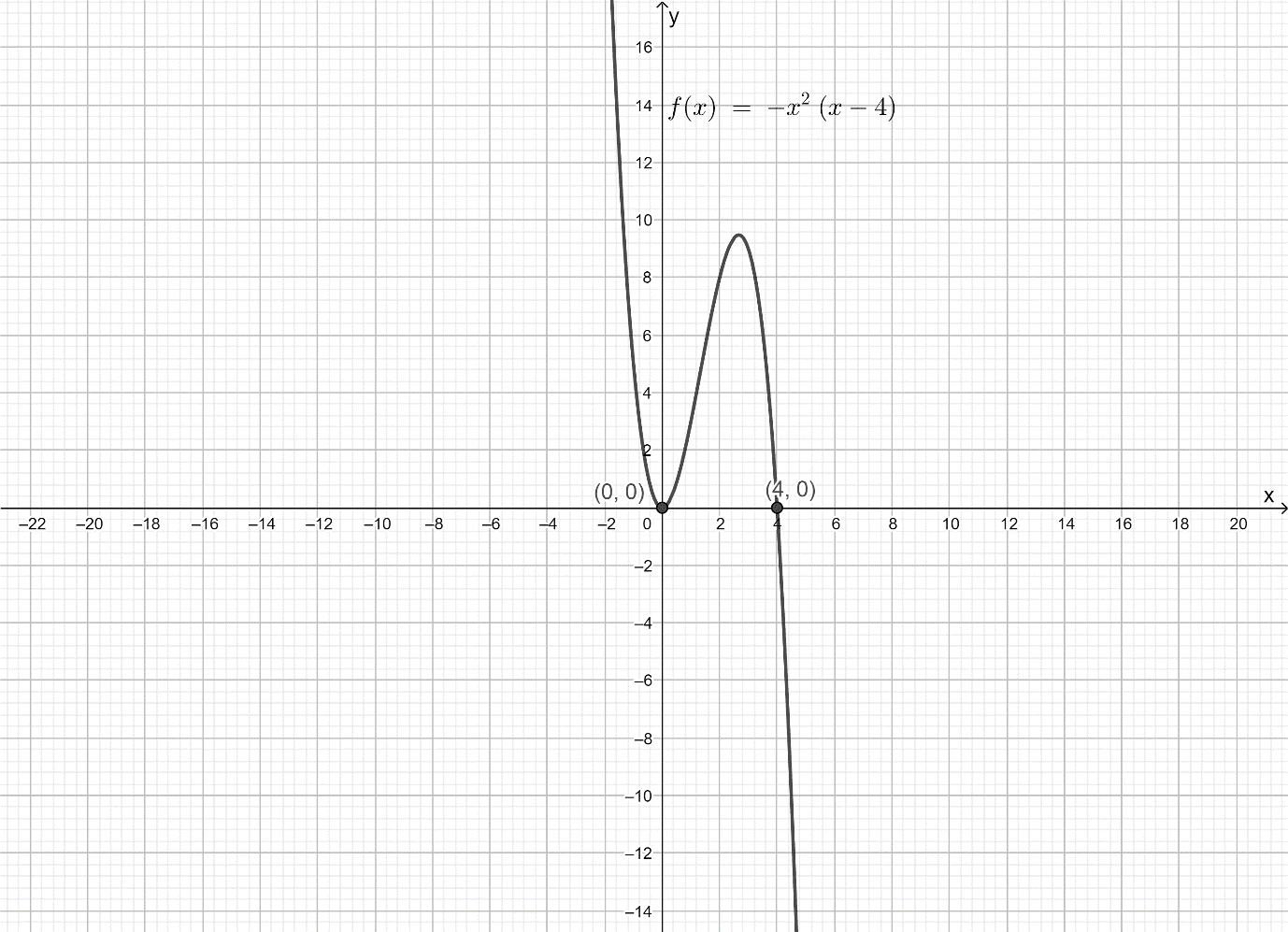
The graph of the function is given below:
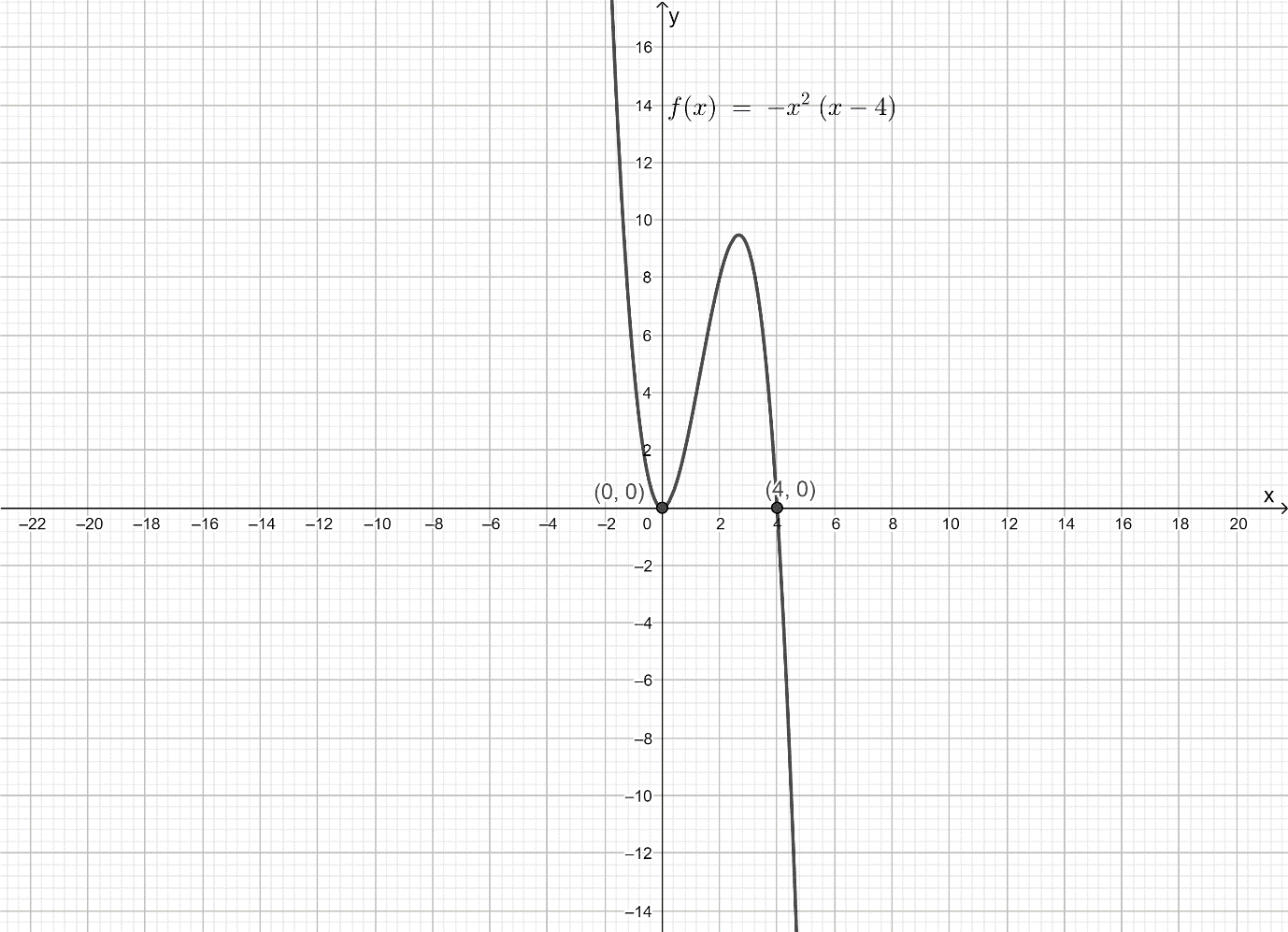
Page 255 Problem 9 Answer
It is given an open box is to be made from a sheet of cardboard that is 9 inches long and 5 inches wide and square flap of side x inches at each corner.
It is required to find the value of x that will produce the box with maximum volume to the nearest tenth.
First, write the dimensions of the box and obtain a volume function. Make the graph of the volume function to find the value of the dimensions.
Find the x2– intercept of graph. Identify the graphs x- intercept, and then use the sign of f(x) on the intervals determined by the x- intercept to find where the graph is above the x- axis and where it’s below the x- axis.
Then, plot the graph and obtain the values.
Find the dimensions of the box.
The length of the box is (9−2x) inches.
The width of the box is (5−2x)inches.
The height of the box is x inches.
Write the volume function. Use the formula,V=Length×width×Height
V=(9−2x)(5−2x)x
Make the graph of the volume function to find the value of the dimensions.
Find the x- intercept of graph. Assume f(x)=(9−2x)(5−2x)x.
Identify the graphs x- intercept. The x- intercept are, x=5/2,x=0, and x=9/2.
Find the intervals of function. So, the graph of f(x)=(9−2x)(5−2x) x is determined by the following three constraints.
9−2x>0, or x<9/2
5−2x>0, or x<5/2
x>0.
Taken together, these constraints give a domain of 0<x<9/2.
The graph for function as follow f(x)=(9−2x)(5−2x)x.
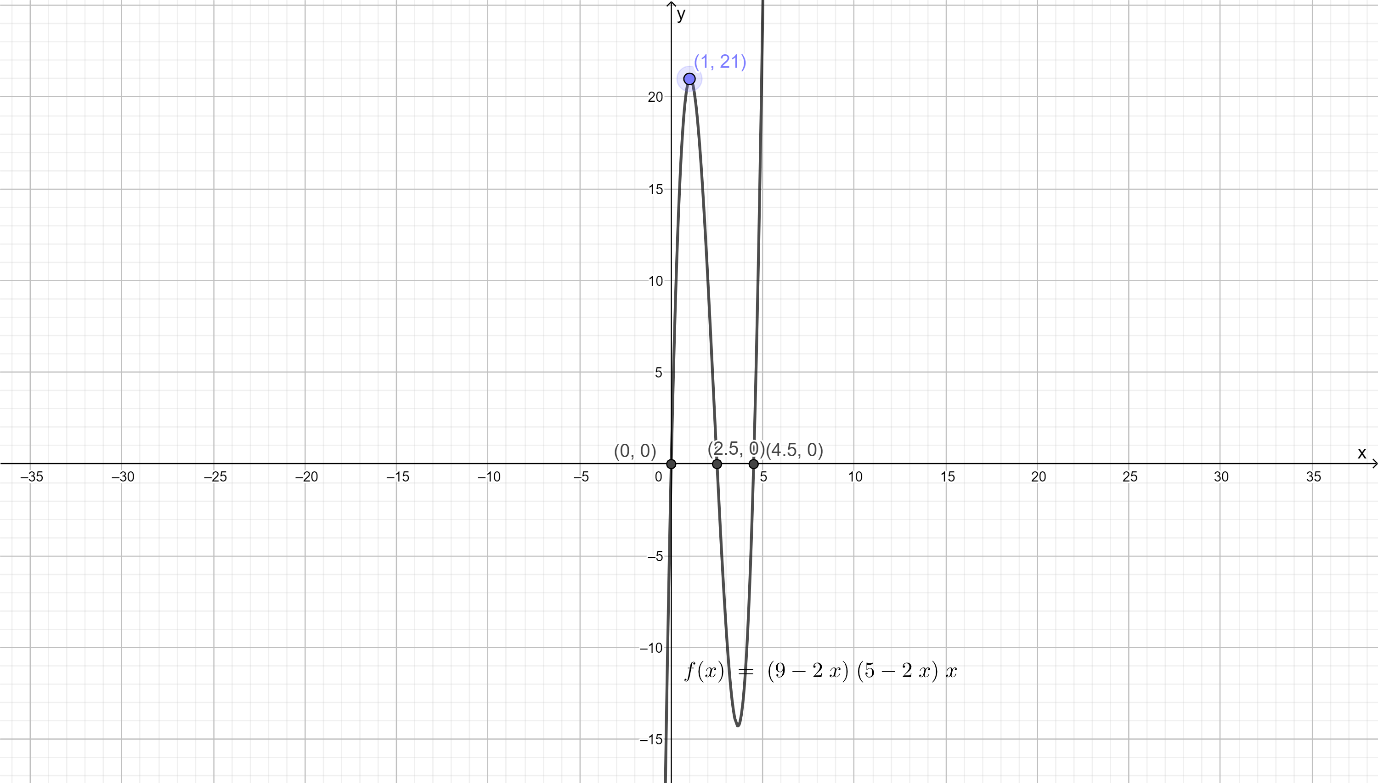
So, f(x)=21.0 when x≈1. Which means that the box has a maximum volume of cub 21 ic inches when square flaps with side length of 1 inches are made in the corners of the sheet of cardboard.
It is observed that when x is equal to 1 box will have maximum volume.
Page 257 Problem 10 Answer
It is required to discuss, although the volume function has three constraints on its domain, then why domain involves only two of them.
For solving equation function it is required to know point of intercept, for volume as a function, curve will intercept at three points on x- axis, hence involves three constrain.
As each dimension must be greater than zero for real world problem.
One of the constrain is bounded by other two.
Therefore, domains involve two constrains only.
In the volume function, one of the constrain is bounded by other two. So, domain involves only two of them.
Page 257 Problem 11 Answer
It is given an open box is to be made from a sheet of cardboard that is 25 inches long and 13 inches wide and square flap of side x inches at each corner.
It is required to find the value of x that will produce the box with maximum volume to nearest tenth.
First, write the dimensions of the box and obtain a volume function. Make the graph of the volume function to find the value of the dimensions.
Find the x- intercept of graph. Identify the graphs x- intercept, and then use the sign of f(x) on the intervals determined by the x- intercept to find where the graph is above the x- axis and where it’s below the x- axis.
Find the dimensions of the box.
The length of the box is (25−2x) inch.
The width of the box is (13−2x) inches.
The height of the box is xinches.
Write the volume function. Use the formula, V=Length×width×Height
V=(25−2x)(13−2x)x
Make the graph of the volume function to find the value of the dimensions.
Find the x- intercept of graph. Assume f(x)=(25−2x)(13−2x)x.
Identify the graphs x- intercept.
x=25/2,x=0, and x=13/2.
Find the intervals of function. So, the graph of f(x)=(13−2x)(25−2x)x is determined by the following three constraints.
13−2x>0, or x<13/2
25−2x>0, or x<25/2 x>0.
Taken together, these constraints give a domain of 0<x<25/2.
Graph for function as follow f(x)=(13−2x)(25−2x)x.
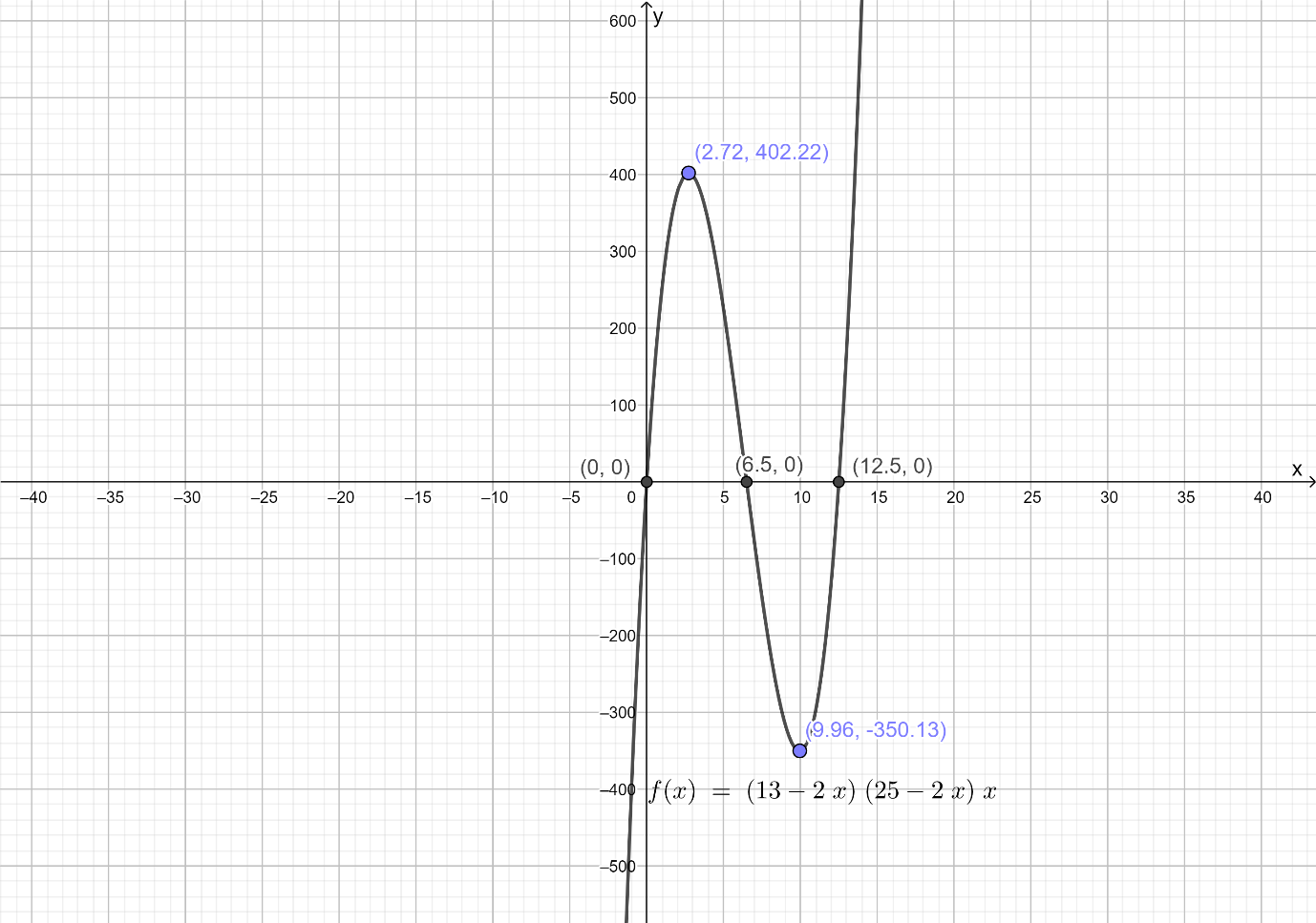
So, f(x)=402.22 when x≈3. Which means that the box has a maximum volume of 402 cubic inches when square flaps with side length of 3 inches are made in the corners of the sheet of cardboard.
It is observed that when x is equal to 3 box will have maximum volume.
Page 257 Problem 12 Answer
It is required to find why is the constant factor important when graphing the function and the function here is a polynomial function with intercept form.
The sign of the function values tells you whether the graph is above or below the x- axis on a particular interval.
Constant factor is determined by sign of the function, further help to describe the end behavior of the curve.
The constant factor changes the sign of the curve and also changes the end behavior it is an important factor.
HMH Algebra 2 Module 5 Chapter 5 Exercise 5.2 Polynomial Functions Answers
HMH Algebra 2 Volume 1 1st Edition Module 5 Chapter 5 Exercise 5.2 Polynomial Functions Page 258 Problem 13 Answer
It is given that f(x)=x7.
It is required to find function’s domain, range, and the end behavior.
Use a graphing calculator, plot the graph. Then, using the graph observe the nature and find the domain range and end behaviour,
Using a graphing calculator the graph of the function f(x)=x7 is as follows:
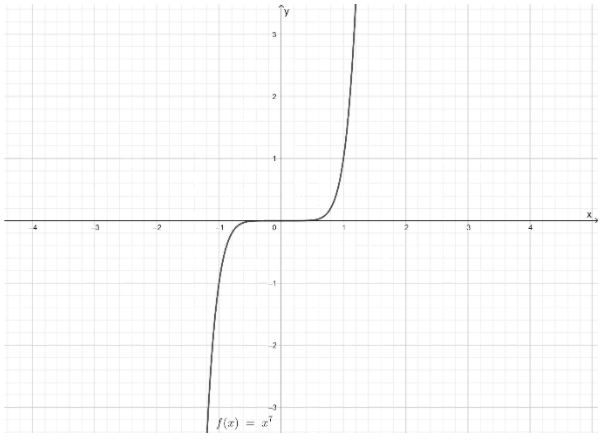
From the above graph, it is observed that domain of the function is (−∞,+∞), range of the function(−∞,+∞) also end behavior can be expressed as,As, x tends to +∞, then f(x) tends to+∞.
As, x tends to−∞, then f(x) tends to −∞.
Domain: (−∞,+∞)
Range: (−∞,+∞)
End behavior: Asx→+∞, f(x)→+∞ and as x→−∞, f(x)→−∞.
Page 258 Problem 14 Answer
It is given thatf(x)=−x9.
It is required to find function’s domain, range, and the end behavior.
Use a graphing calculator, plot the graph. Then, using the graph observe the nature and find the domain range and end behavior.
Using a graphing calculator, the graph of the functionf(x)=−x9 is as follows:
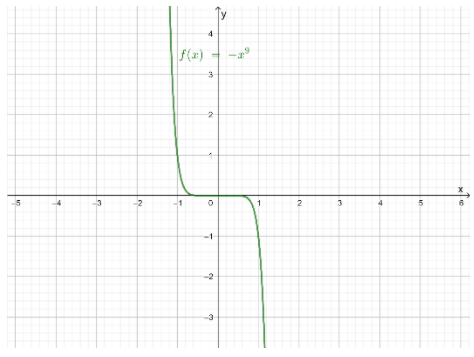
Assumey=−x9.
The function can take all the values of the real line and give all the output values of the real line.
Therefore, the domain and range of the function will be. (−∞,+∞)
From the graph, observe that the function approaches ∞ at x=∞ and it approaches−∞ at x=−∞.
The graph of the function, f(x)=−x9 is given below.

The following values are obtained from the graph of the function.
Domain:(−∞,+∞)
Range: (−∞,+∞)
End behavior: Asx→+∞, f(x)→−∞and as x→−∞, f(x)→∞.
HMH Algebra 2 Volume 1 1st Edition Module 5 Chapter 5 Exercise 5.2 Polynomial Functions Page 258 Problem 15 Answer
It is given that f(x)=x10.
It is required to find function’s domain, range, and the end behavior.
Use a graphing calculator, plot the graph. Then, using the graph observe the nature and find the domain range and end behavior.
Using a graphing calculator, the graph of the function f(x)=x10 is as follows:
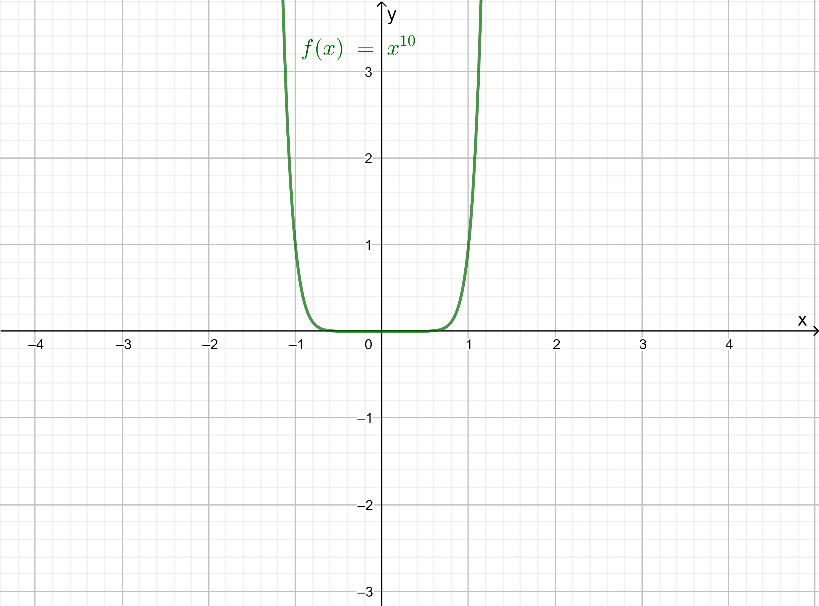
Assume y=x10.
The function can take all the values of the real line but it will give only positive output values of the real line because of an even exponent.
Therefore, the domain of the function is R and range of the function will be R+∪{0}.
From the graph, observe that the function approaches ∞at x=∞ and it approaches ∞ at x=−∞.
The graph of the function, f(x)=x10is given below.
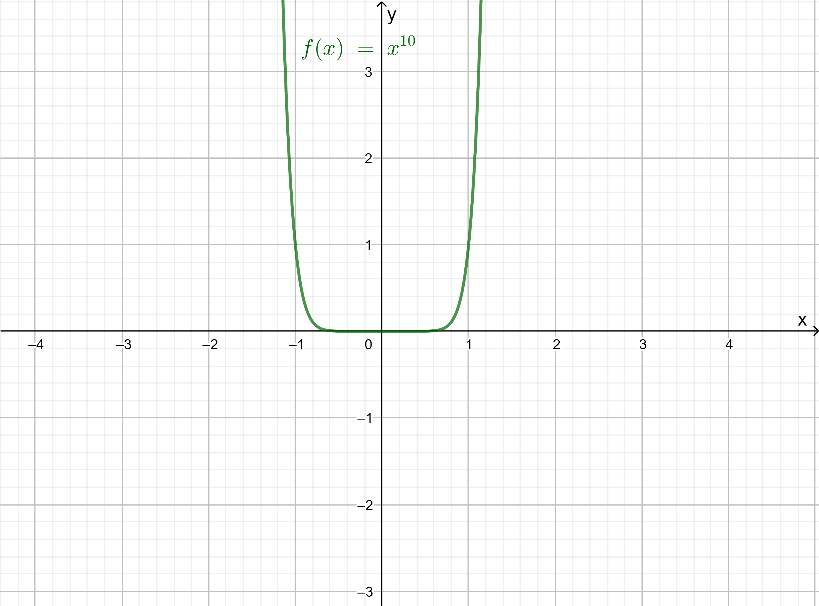
The following values are obtained from the graph of the function.
Domain: R
Range: R+∪{0}
End behavior: Asx→+∞, f(x)→∞ and as x→−∞, f(x)→∞.
Page 258 Problem 16 Answer
It is given that f(x)=−x8.
It is required to find function’s domain, range, and the end behavior.
Use a graphing calculator, plot the graph. Then, using the graph observe the nature and find the domain range and end behavior.
Using a graphing calculator, the graph of the function f(x)=−x9 is as follows:
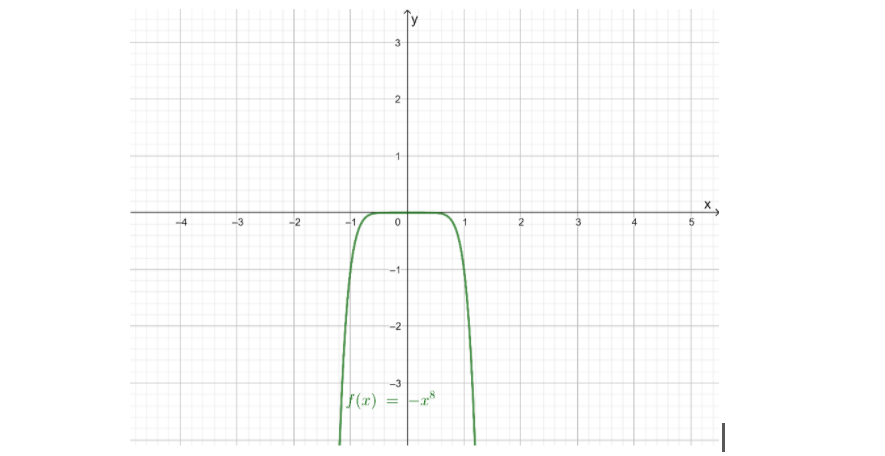
Assume y=−x8. The function can take all the values of the real line but it will give only negative output values of the real line because of a negative at the beginning.
Therefore, the domain of the function is R and range of the function will be R−∪{0}.
From the graph, observe that the function approaches−∞
at x=∞ and it approaches −∞ at x=−∞.
The graph of the function, f(x)=−x8 is given below.
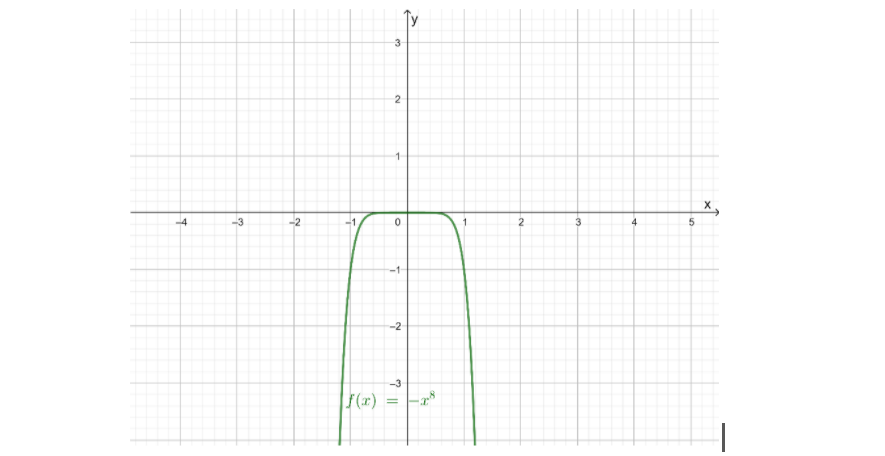
The following values are obtained from the graph of the function.
Domain: R
Range: R−∪{0}
End behavior: As x→+∞, f(x)→−∞ and as x→−∞, f(x)→−∞.
HMH Algebra 2 Volume 1 1st Edition Module 5 Chapter 5 Exercise 5.2 Polynomial Functions Page 258 Problem 17 Answer
It is given that f(x)=x(x+1)(x+3).
It is required to graph the function using a graphing calculator and use the graph to determine the turning points and the type of maximum and minimum values.
Use a graphing calculator, plot the graph. Then, using the graph observe the nature and find the required values.
Use a graphing calculator and plot f(x)=x(x+1)(x+3).
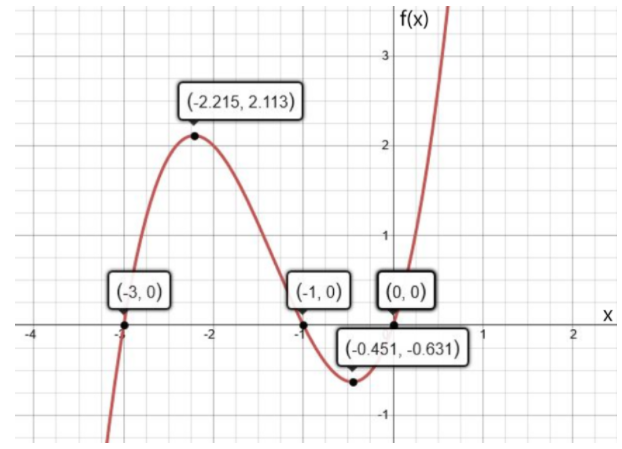
Now, from the graph observe that graph changes its concavity at two points. So, there are two turning points.
Those two turning points are (−2.215,2.113) and (−0.45,−0.63).
The function is at peak at the point (−2.215,2.113) and at it lowest peak at (−0.45,−0.63).
Therefore,(−2.215,2.113) is local maxima and (−0.45,−0.63) is the local minima.
The graph of the function is given below and the function has following attributes.
Turning points: 2
Turning points coordinates: (−2.215,2.113), (−0.45,−0.63).
Local maxima:(−2.215,2.113)
Local minimum: (−0.45,−0.63)
Global maximum or minimum: None
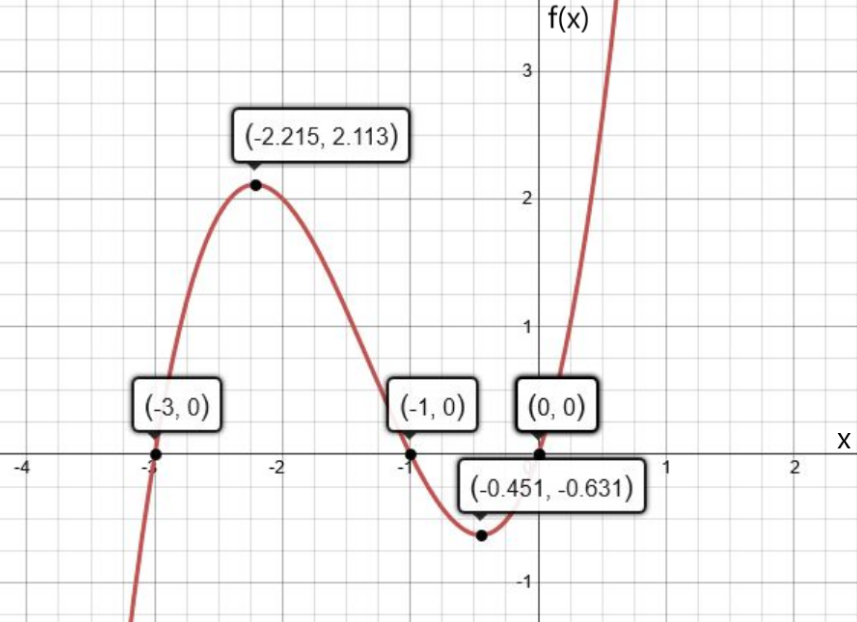
Page 258 Problem 18 Answer
It is given that f(x)=(x+1)2(x−1)(x−2).
It is required to graph the function using a graphing calculator and use the graph to determine the turning points and the type of maximum and minimum values.
Use a graphing calculator, plot the graph. Then, using the graph observe the nature and find the required values.
Use a graphing calculator and plot f(x)=(x+1)2(x−1)(x−2).
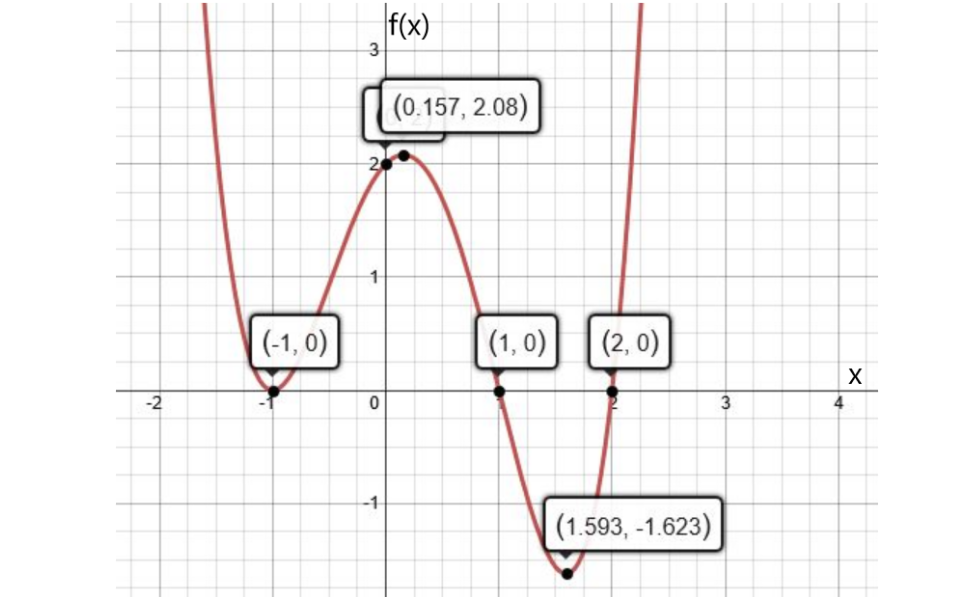
Now, from the graph observe that graph changes its concavity at three points. So, there are three turning points.
Those three turning points are (0.157,2.08), (1.593,−1.623) and(−1,0).
The function is at peak at the point (0.157,2.08) and at minimum at (−1,0).
Therefore, (0.157,2.08) is local maxima and (−1,0) is the local minima. The global minima is(1.593,−1.623).
The graph of the function is given below and the function has following attributes.
Turning points: 3
Turning points coordinates: (0.157,2.08), (1.593,−1.623) and (−1,0).
Local maxima:(0.157,2.08)
Local minimum: (−1,0)
Global minimum: (1.593,−1.623)

Page 258 Problem 19 Answer
It is given that f(x)=−x(x−1)(x+2)2.
It is required to graph the function using a graphing calculator and use the graph to determine the turning points and the type of maximum and minimum values.
Use a graphing calculator, plot the graph. Then, using the graph observe the nature and find the required values.
Use a graphing calculator and plot f(x)=−x(x−1)(x+2)2.
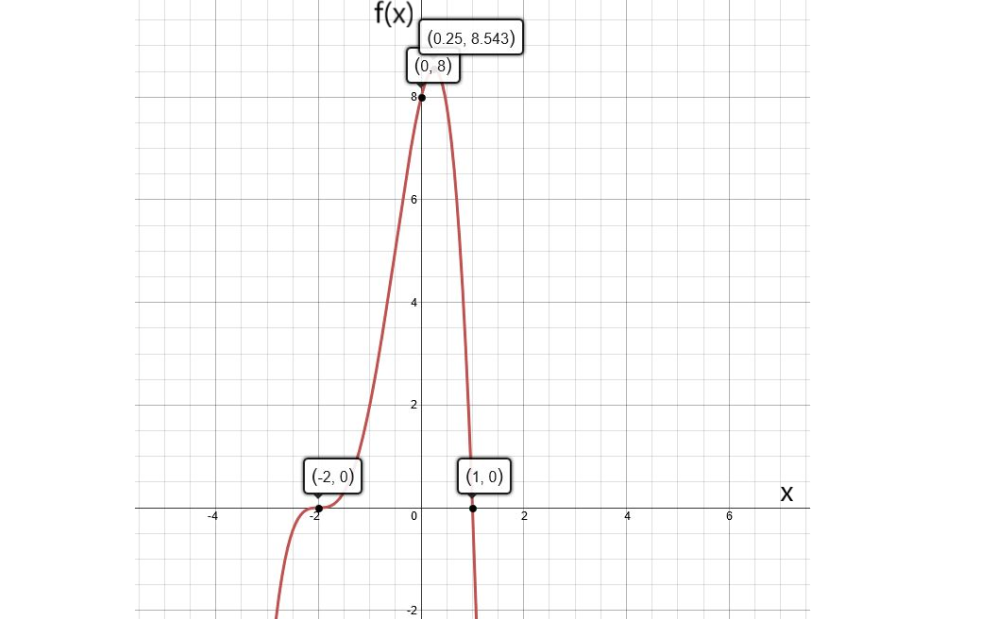
Now, from the graph observe that graph changes its concavity at three points. So, there is only one turning point, (0.25,8.543).
And the function has global minimum atx=0.25.
The graph of the function is given below and the function has following attributes.
Turning points: 1
Turning points coordinates: (0.25,8.543)
Local maxima: None
Local minimum: None
Global minimum:(0.25,8.543)
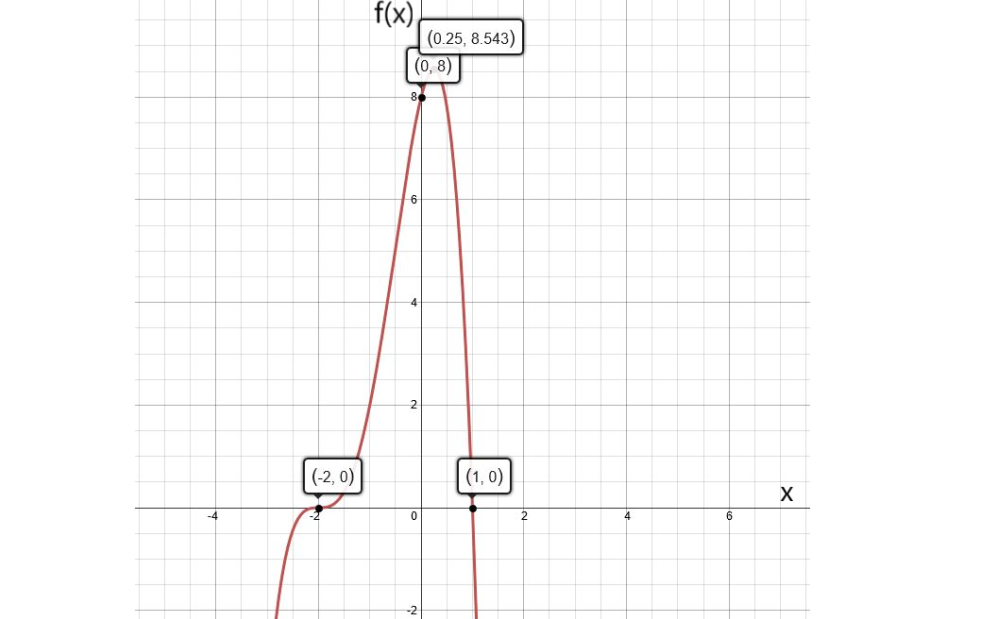
Page 259 Problem 20 Answer
It is given that f(x)=−x(x−2)2.
It is required to graph the function.
Use a graphing calculator, and plot the graph of the given function.
Use a graphing calculator and plot f(x)=−x(x−2)2.

The graph of the function is given below.
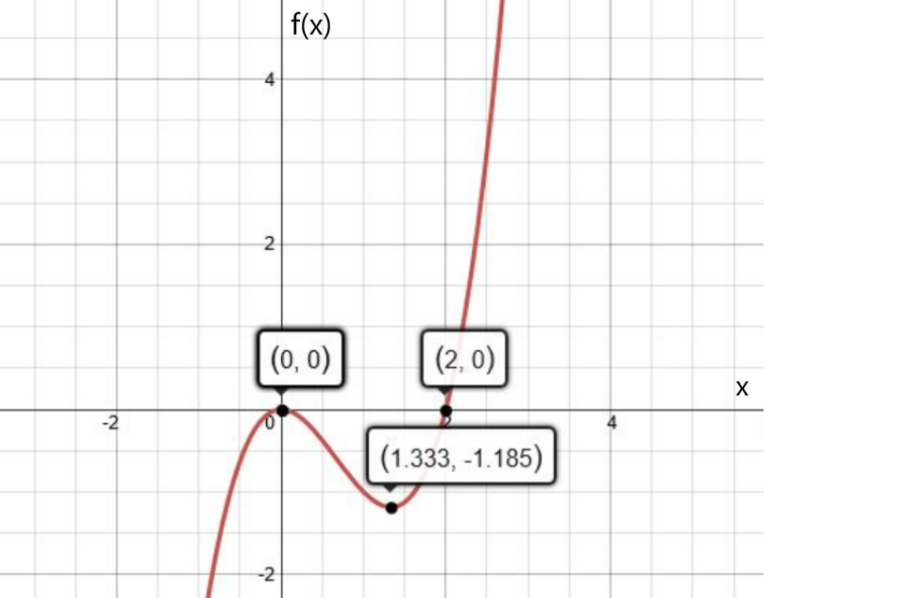
HMH Algebra 2 Chapter 5 Exercise 5.2 Polynomial Functions Key
HMH Algebra 2 Volume 1 1st Edition Module 5 Chapter 5 Exercise 5.2 Polynomial Functions Page 259 Problem 21 Answer
It is given that f(x)=−x(x+1)(x−2)(x−3).
It is required to graph the function.
Use a graphing calculator, and plot the graph of the given function.
Use a graphing calculator and plot f(x)=−x(x+1)(x−2)(x−3).
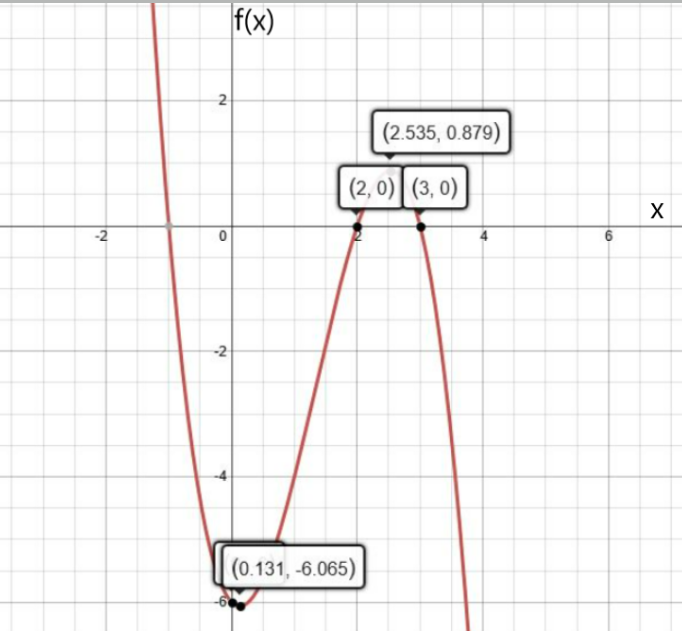
The graph of the function is given below.
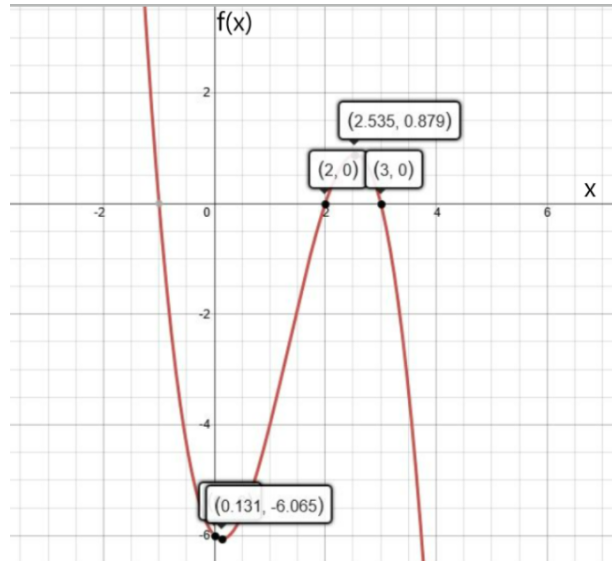
Page 260 Problem 22 Answer
It is given an open-top box out of cardboard that is 6 inches long and 3 inches wide, you make a square flap of side length x inches in each corner by cutting along one of the flap’s sides and folding along the other.
Once you fold up the four sides of the box, you glue each flap to the side it overlaps.
It is required to find the value of x
that maximize the volume of the box.
To find the required answer, find the dimension of the box once the flaps have been made and the sides have been folded up.
Create a volume function for the box. Maximize the volume for a given x, differentiate the volume with respect to x, and equal to zero, to find the value of x that maximizes the volume.
Write expression for the dimension of the box.
The length of the box is 6−2x units.
The width of box is3−2x units.
The height of the box is x units.
Now write the volume function and determine its domain. Use the formula, V=Length×width×Height.
Substitute length as 6−2x, breadth as 3−2x, and height as x in the above formula and simplify.
V=(6−2x)(3−2x)x
=(6×3−6×2x−2x×3+2x×3x)×x
=(18−12x−6x+6x2)×x
=4x3−18x2+18x
Thus, the volume function is V=4x3−18x2+18x.
To maximize the volume for a given x, differentiate the volume with respect to x and equal to zero.
Use the power rule of differentiation,d/dx(xn)=nxn−1.
dV/dx=0
d/dx(4x3−18x2+18x)=0
12x3−36x+18=0
Here, the x has two values 2.366 and 0.634. Since the value of x cannot be more than half the width 3, choose x=0.634, that maximize the volume.
Find the maximum volume.
Substitute x as 0.634 in V=4x3−18x2+18x and simplify.
Vmax
=4(0.634)3−18(0.634)2+18(0.634)
=1.019−7.235+11.412
=5.196
Hence, the maximum volume is 5.196 inches 3.
The value of x that maximize the volume of the box is 0.634. Also, the maximum volume is 5.196 inches 3.
HMH Algebra 2 Volume 1 1st Edition Module 5 Chapter 5 Exercise 5.2 Polynomial Functions Page 261 Problem 23 Answer
It is given a graph of a polynomial that cuts the x axis at 4 points.
It is required to find a quadratic function in intercept form for the given graph whose x-intercepts are integers assuming that the constant factor a is either 1 or−1.
First, identify the x-intercept that means find out the points where the curve cut the x axis, make them in factor form.
Then, write the polynomial as product of all the factors and assume the constant as 1 to get the function.
Analyse the given graph, where it cuts the x axis. Therefore, it cuts the axis at x=−3,x=0,x=4, and x=2.
Let P(x) be the polynomial.
As x=−3 is a zero so, (x+3) is a factor.
As x=0 is a zero so, x is a factor.
As x=4 is a zero so, (x−2) is a factor.
As x=2 is a zero so, (x−4) is a factor.
The polynomial is factored form will beP(x)=ax(x+3)(x−2)(x−4).
Check the end behavior of the polynomial.
The end behavior of the polynomial is x→∞ then, P(x)→∞ and when x→−∞ then, P(x)→∞ Therefore, a=1.
Thus,P(x)=x(x+3)(x−2)(x−4) is the required function.
The quadratic function in intercept form for the given graph isP(x)=x(x+3)(x−2)(x−4).
Page 261 Problem 24 Answer
It is given a graph of a polynomial that touches the x axis at 2 points.
It is required to find a quadratic function in intercept form for the given graph whose x-intercepts are integers assuming that the constant factor a is either 1 or −1.
First, identify the x-intercept that means find out the points where the curve cut the x axis, make them in factor form.
Then, write the polynomial as product of all the factors and assume the constant as 1 to get the function.
Analyse the given graph, where it cuts the x-axis. Therefore, it cuts the axis at x=3, and x=−2.
Let P(x) be the polynomial.
As x=3 is a zero of multiplicity so, (x−3)2 is a factor.
Asx=−2 is a zero of multiplicity so,(x+2)2 is a factor.
The polynomial is factored form will be P(x)=a(x−3)2(x+2)2.
Check the end behaviour of the polynomial.
The end behaviour of the polynomial is x→∞ then, P(x)→−∞ and whenx→−∞ then, P(x)→−∞.
Therefore, a=−1.
Thus, P(x)=−(x−3)2(x+2)2 is the required function.
The quadratic function in intercept form for the given graph is P(x)=−(x−3)2(x+2)2.
HMH Algebra 2 Exercise 5.2 Polynomial Functions Answer Guide
HMH Algebra 2 Volume 1 1st Edition Module 5 Chapter 5 Exercise 5.2 Polynomial Functions Page 262 Problem 25 Answer
It is given a function f(x)=(x−1)2(x+2).
It is required to find the statement that the x-intercept are x=1 and x=−2 is applicable or not for the given function.
To find, the statement true or not draw the graph of f(x)=(x−1)2(x+2) using a graphing calculator.
Find out the x intercept. Then check the obtained point are same or not with the given statement to find out is the given statement applicable or not.
Draw the graph of f(x)=(x−1)2(x+2) using a graphing calculator.
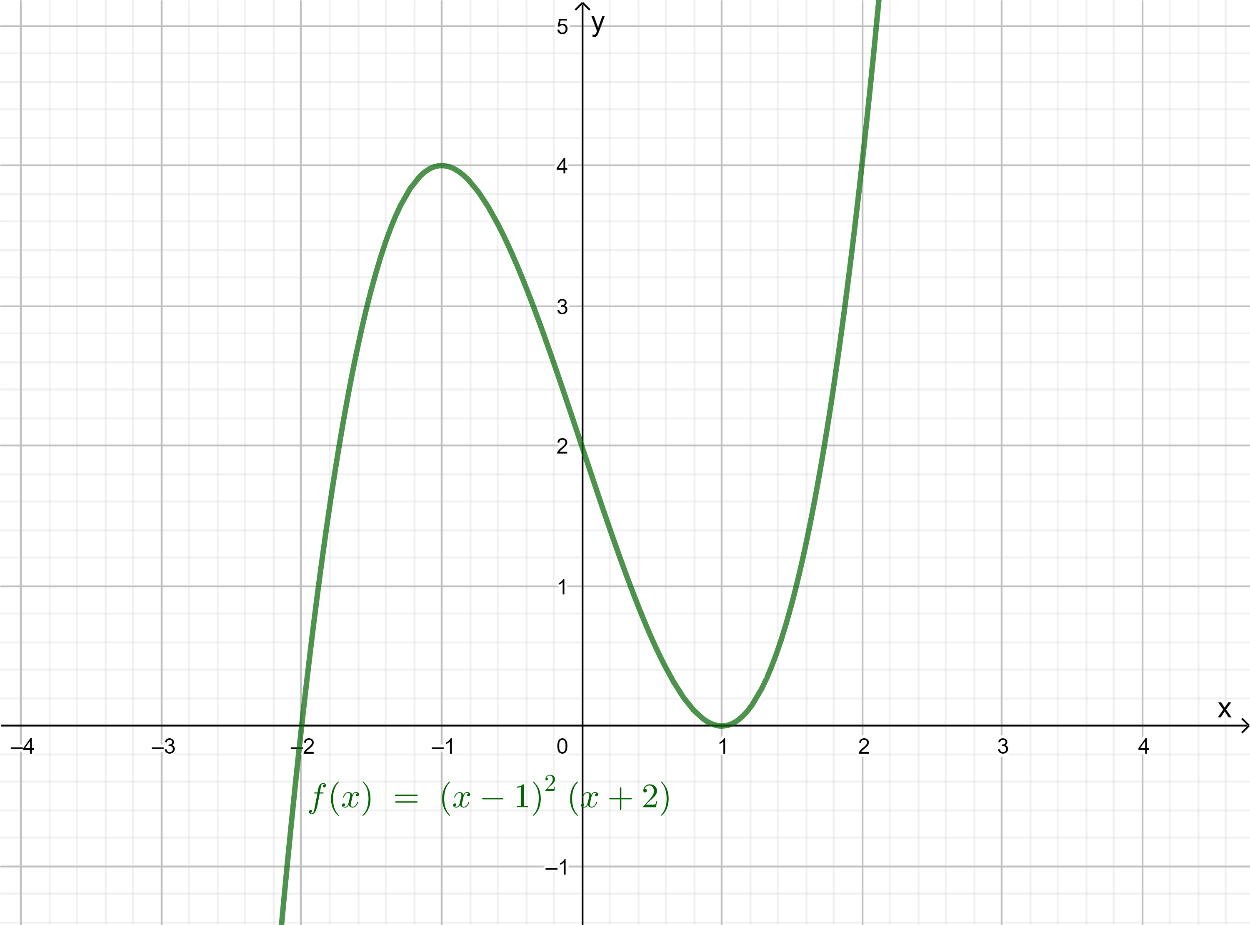
From the graph, it is observed that the curve cuts the x axis at x=−2 and the curve touches the x axis at x=1.
It means the curve is tangent to the x-axis at x=1.
Therefore the statement that the x-intercept are x=1 and x=−2 is applicable.
Statement A: The x-intercepts of f(x) are x=1 and x=−2 is true for the function f(x)=(x−1)2(x+2).
Page 262 Problem 26 Answer
It is given a function f(x)=(x−1)2(x+2).
It is required to find the statement that the x-intercept are x=−1 and x=2 is applicable or not for the given function.
To find, the statement true or not draw the graph of f(x)=(x−1)2(x+2) using a graphing calculator.
Find out the x-intercept. Then check the obtained point are same or not with the given statement to find out is the given statement applicable or not.
Draw the graph of f(x)=(x−1)2 (x+2) using a graphing calculator.
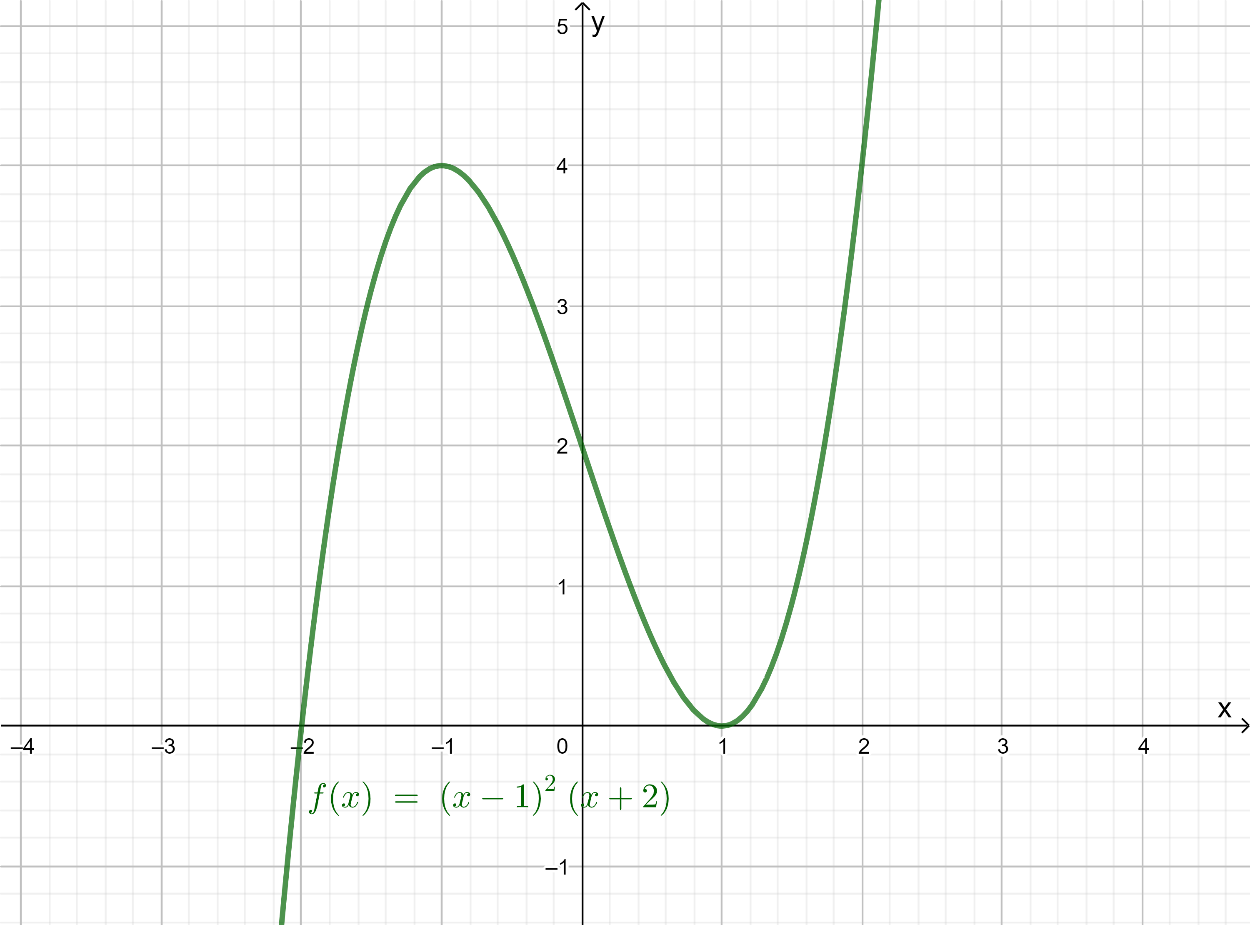
From the graph, it is observed that the curve cuts the x axis atx=−2 and the curve touches the x axis at x=1.
It means the curve is tangent to the xaxis atx=1.
Therefore, the statement that the x intercept arex=−1 and x=2 is not applicable for the given function.
Statement B: The x-intercepts of f(x) are x=−1 and x=2 is not true for the function f(x)=(x−1)2(x+2).
Page 262 Problem 27 Answer
It is given a function f(x)=(x−1)2(x+2).
It is required to find whether the statement that the graph cross the $x$ axis and x=1, and is tangent to the x axis atx=−2 applies to the function or not.
To find, the statement true or not draw the graph of f(x)=(x−1)2(x+2)
using a graphing calculator. Find out the x intercept.
Then, check the obtained point are same or not with the given statement to find out is the given statement applicable or not.
Draw the graph of f(x)=(x−1)2(x+2) using a graphing calculator.

From the graph it is observed that the curve does not cross the x axis at x=1 and it is not tangent to x=−2.
Therefore, this is not applicable for the given function.
Statement C: The graph cross the x axis and x=1, and is tangent to the x axis at x=−2 is not true for the function f(x)=(x−1)2(x+2).
HMH Algebra 2 Volume 1 1st Edition Module 5 Chapter 5 Exercise 5.2 Polynomial Functions Page 262 Problem 28 Answer
It is given a function f(x)=(x−1)2(x+2).
It is required to find the statement that the graph cross the x-axis atx=−1, and is tangent to the x axis at x=2 is applicable or not for the given function.
To find, the statement true or not draw the graph of f(x)=(x−1)2(x+2) and find out the x-intercept means find the point where the curve cut the x axis.
Then check the obtained point are same or not with the given statement to find out is the given statement applicable or not.
Draw the graph of f(x)=(x−1)2(x+2).

From the graph it is observed that the curve does not cross the x axis at x=−1, and is tangent to the x axis at x=2 is not applicable for the given function.
Statement D: The graph crosses the x-axis atx=−1, and is tangent to the x axis at x=2 not applicable for the given function
f(x)=(x−1)2(x+2).
Page 262 Problem 29 Answer
It is given a function, f(x)=(x−1)2(x+2).
It is required to tell whether the graph is tangent to the x-axis at x=1 and crosses the x-axis at x=−2.
Plot the lines on the graph off(x)=(x−1)2(x+2) which is inferred from part (A).
Then, observe the graph and get the required answer.
Plot the linex=1 and x=−2 on the graph off(x)=(x−1)2(x+2).
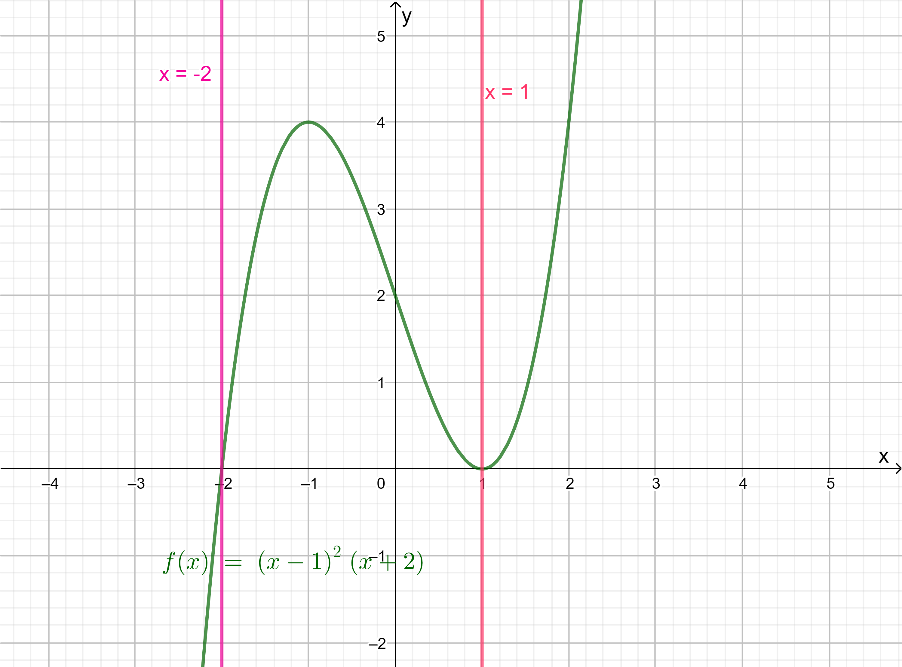
From the graph observe that the graph is tangent to the x-axis atx=1 and crosses the x-axis at x=−2.
Therefore, the statement applies.
The statement E applies to the graph of f(x)=(x−1)2(x+2).
Page 262 Problem 30 Answer
It is given a functionf(x)=(x−1)2(x+2).
It is required to find whether the statement that the graph is tangent to the x-axis at x=−1, and is tangent to the x-axis at x=2 applies to the function or not.
To find, the statement true or not draw the graph of f(x)=(x−1)2(x+2)using a graphing calculator.
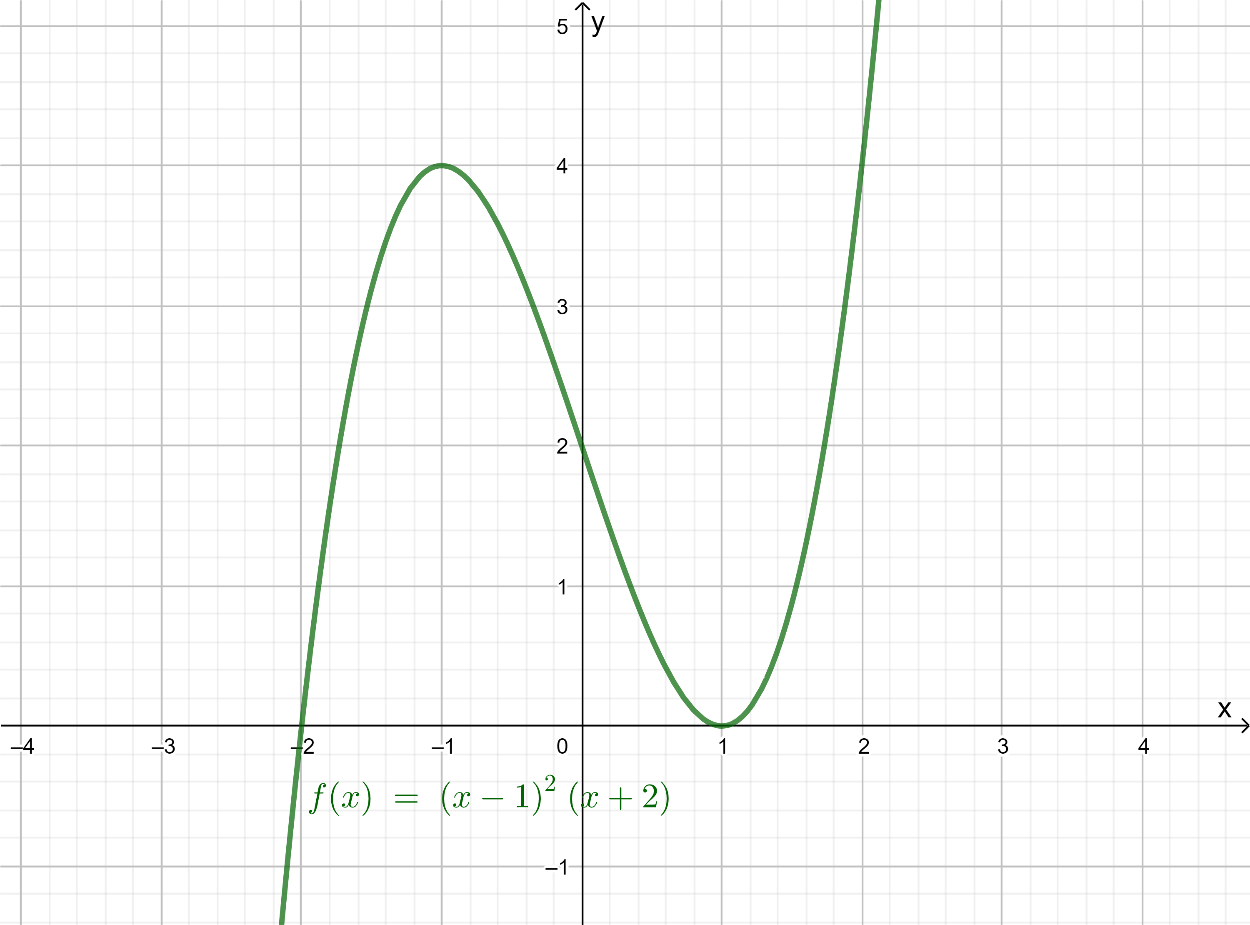
Find out the x intercept. Then, check the obtained point are same or not with the given statement to find out is the given statement applicable or not.
Draw the graph of f(x)=(x−1)2(x+2) using a graphing calculator.
From the graph it is observed that the curve is not tangent to the x-axis at x=−1, and is tangent to the x-axis at x=2.
Therefore, the is not applicable for the given function.
Statement C: The graph is tangent to the x-axis at x=−1, and is tangent to the x-axis at x=2 is not true for the function f(x)=(x−1)2(x+2).
HMH Algebra 2 Volume 1 1st Edition Module 5 Chapter 5 Exercise 5.2 Polynomial Functions Page 262 Problem 31 Answer
It is given a function f(x)=(x−1)2(x+2).
It is required to find whether the statement that the graph is a local, but not global minimum occurs at interval −2<x<1, and a local, but not global, maximum occurs at x=1 applies to the function or not.
The graph inferred from part(a) is as follows.
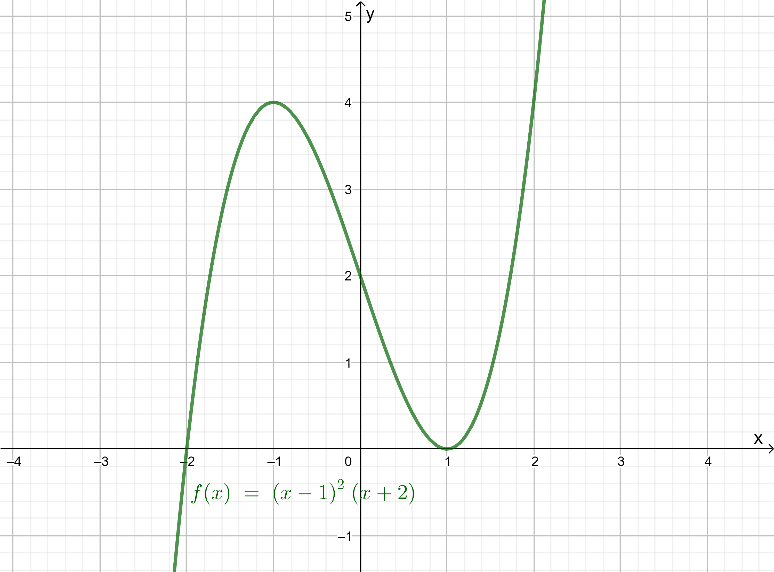
Observe that the graph is increasing in the interval −2<x<1.
So, it cannot be the global minimum.
The global maximum cannot occur at x=1 because the value of function is zero at that point but actually the value of function increases.
Therefore, the given statement is not valid.
The statement the graph is a local, but not global minimum occurs at interval −2<x<1, and a local, but not global, maximum occurs at x=1
does not apply to the function or not.
Page 262 Problem 32 Answer
It is given a function f(x)=(x−1)2(x+2)
.It is required to find whether the statement that the graph is a local, but not global maximum occurs at interval −2<x<1 , and a local, but not global, minimum occurs at x=1
applies to the function or not.
The graph inferred from part(a) is as follows.
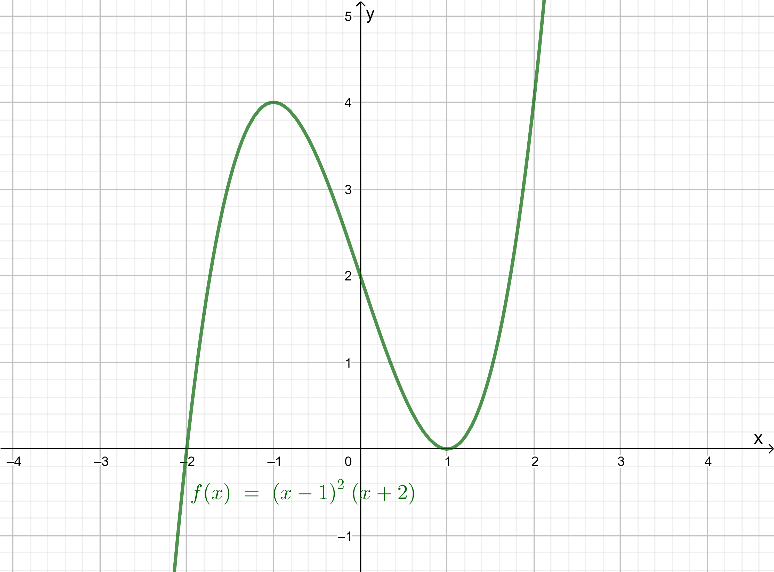
Observe that the graph is increasing in the interval −2<x<1.
So, it is the global minimum.
Therefore, the given statement is valid.
The statement the graph is a local, but not global maximum occurs at interval −2<x<1, and a local, but not global, minimum occurs at x=1 applies to the function.
Page 262 Problem 33 Answer
It is given a function f(x)=(x−1)2(x+2).
It is required to find whether the statement that the graph is a local, but not global minimum occurs at interval −1<x<2, and a local, but not global, maximum occurs at x=2 applies to the function or not.
The graph inferred from part(a) is as follows.

By observing the graph it is deduced that the given statement is invalid.
The statement the graph is a local, but not global maximum occurs at interval −1<x<2, and a local, but not global, minimum occurs at x=2 does not apply to the function.
HMH Algebra 2 Volume 1 1st Edition Module 5 Chapter 5 Exercise 5.2 Polynomial Functions Page 262 Problem 34 Answer
It is given a function f(x)=(x−1)2(x+2).
It is required to find whether the statement that the graph is a local, but not global maximum occurs at interval −1<x<2, and a local, but not global, minimum occurs at x=2
applies to the function or not.
The graph inferred from part(a) is as follows.
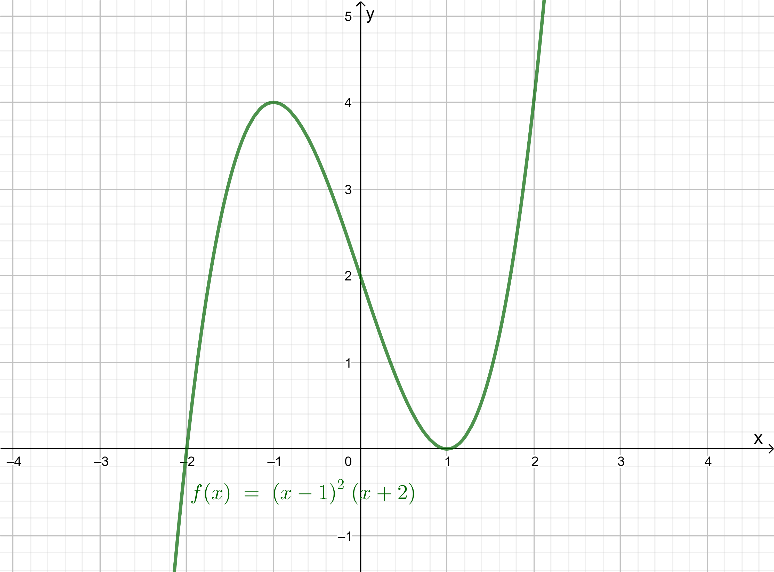
By observing the graph it is deduced that the given statement is invalid.
The statement the graph is a local, but not global maximum occurs at interval−1<x<2, and a local, but not global, minimum occurs at x=2 does not apply to the function.
Page 266 Exercise 1, Answer
It is to require to identify the transformation of the graph f(x)=x3 to produce the graph of the function
g(x)=(−1/4(x+2))3+3.
The given cubic function is of the form h(x)=a(1/b(x−h))3+k.
For g(x), h=−2,k=3, b=−1/4, and a=1.
Thus, according to the rule of the cubic function h(x), first, do a vertical translation of 3 units up.
Then, a horizontal translation of 2 units left followed by a horizontal sketch by a factor of 4.
Then, finally reflect the curve obtained about x-axis.
The required transformation is vertical translation of 3 units up.
Then, a horizontal translation of 2 units left followed by a horizontal sketch by a factor of 4.
Finally, reflect the curve obtained about x-axis.
Page 266 Exercise 2, Answer
It is to require to identify the transformation of the graph f(x)=x3 to produce the graph of the function h(x)=1/3(x−4)3.
The given cubic function is of the form h(x)=a(1/b(x−h))3+k.
For g(x), h=4,k=0, b=1, and a=1/3.
Thus, according to the rule of the cubic function h(x), first, do a horizontal translation of 4 units right.
Then, a vertical compression by a factor of 3.
The required transformation is a horizontal translation of 4 units right followed by a vertical compression by a factor of 3.
Step-By-Step Solutions For HMH Algebra 2 Module 5 Exercise 5.2
HMH Algebra 2 Volume 1 1st Edition Module 5 Chapter 5 Exercise 5.2 Polynomial Functions Page 266 Exercise 3, Answer
It is given that s(x)=x(x+2)(x+1)2.
It is required to determine the number of turning points, global maximums and minimums, and local maximums and minimums.
First, make the graph of the function using a graphing calculator. Then, observe the maximum and minimum, and all other required values.
Graph the function s(x)=x(x+2)(x+1)2using a graphing calculator.
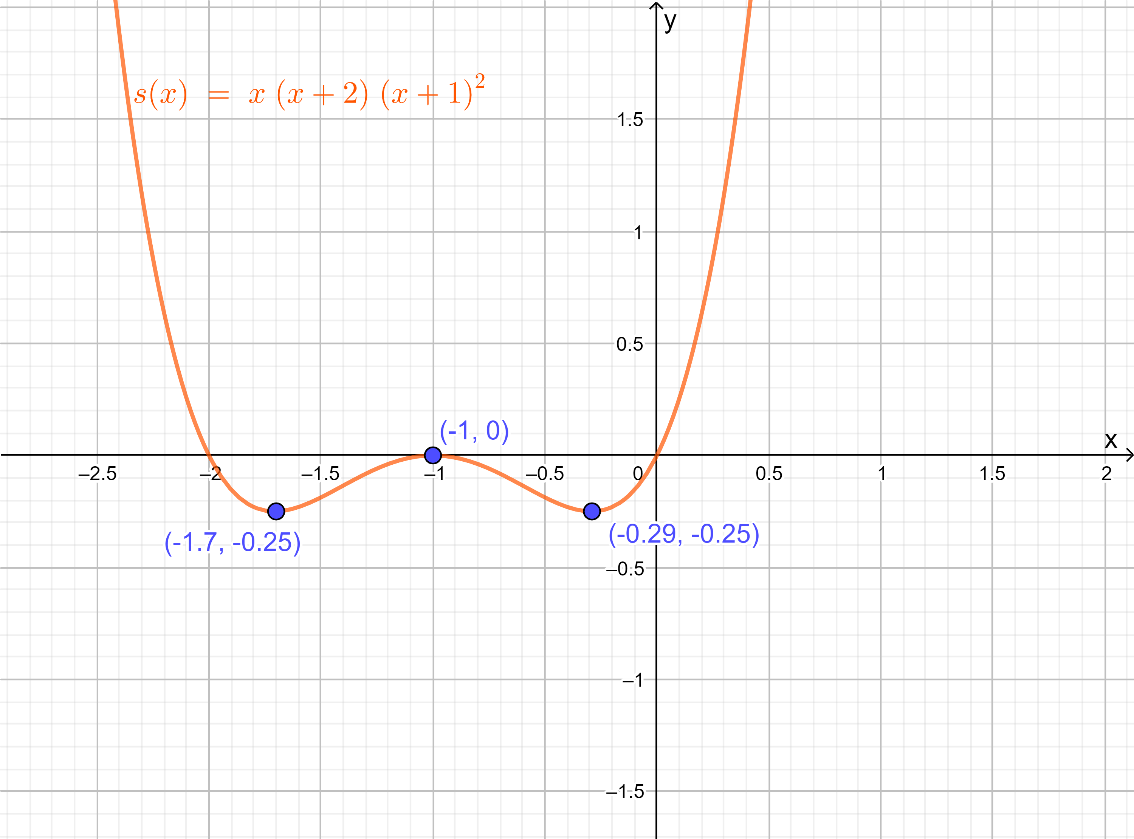
The turning points lie at (−1.70,−0.25), (−1,0), (−0.29,−0.25)
From the graph observe that there are no global minima or global maxima because the concavity of the curve is changing frequently.
The local minima occur at (−1.70,−0.25), and (−0.29,−0.25).
The maxima occur at (−1,0).
According to the graph, there are three turning points, one local maximum, no global minimum.
The turning points are (−1.70,−0.25), (−1,0), (−0.29,−0.25).
The local minima is at (−1.70,−0.25), and (−0.29,−0.25), and the maxima occur at(−1,0).

Page 266 Exercise 4, Answer
It is given that h(x)=x2(x−3)(x+2)(x−2).
It is required to determine the number of turning points, global maximums and minimums, and local maximums and minimums.
First, make the graph of the function using a graphing calculator. Then, observe the maximum and minimum, and all other required values.
Graph the function h(x)=x2(x−3)(x+2)(x−2) using a graphing calculator.

The turning points lie at (0,0),(2.53,−7.24),(1.24,6.66), and (−1.47,17.76).
From the graph observe that there are no global minima or global maxima because the concavity of the curve is changing frequently.
The local minima occur at (0,0), and (2.53,−7.24).
The maxima occur at (1.24,6.66).
According to the graph, there are three turning points, one local maximum, no global minimum.
The turning points are (0,0),(2.53,−7.24),(1.24,6.66), and .
The local minima is at (2.53,−7.24), and (0,0), and the maxima occur at (1.24,6.66).
Page 266 Exercise 5, Answer
It is required to write a real-world situation that could be modeled by the equation V(ω)=ω(5ω)(3ω).
Consider a cuboidal tank of length ω,width 5ω units and height 3ω units.
The volume of a cuboidal tank is the product of its length, breadth, and height.
Let V be volume of cuboid then volume of cuboid isV(ω)=ω(5ω)(3ω).
The equation V(ω)=ω(5ω)(3ω) can be modeled as the volume of a cuboidal tank with side lengths, ω, 5ω, and 3ω.
HMH Algebra 2 Volume 1 1st Edition Module 5 Chapter 5 Exercise 5.2 Polynomial Functions Page 266 Exercise 6, Answer
It is given function that g(x)=−1/4(x+4)3.
It is to require to identify changes to y when the graph of f(x)=x3 is transformed to get the graph of g(x).
Identify the transformation that is done to the y coordinates and apply them to the coordinates.
On y-axis, compress f(x)= x3 by factor 0.25 along the vertical axis.
The y-coordinates of the reference points are −1, 0, and 1.
Therefore, changes in y are−0.25(−1)=0.25,−0.25(0)=0,and−0.25(1)=−0.25.
The changes toy are −1 becomes 0.25, 0 becomes 0, and 1 becomes 0.25.
The values of y after the changes is 0.25, 0, and 0.25.
Page 267 Exercise 7, Answer
It is given function f(x)=x3and g(x)=−1/4(x+4)3.
It is required to identify the transformation using the changes to x, and y and complete the table.
To do so, use the values of x obtained in question 1 and 2. Substitute it in the function f(x) and g(x) and fill the tables with the required values.
To get the graph of g(x)=−1/4(x+4)3, the graph of f(x)=x3compressed vertically and translated to left.
On substituting values obtained from question 1 and 2.

The complete table as follows:

Page 267 Exercise 8, Answer
It is given that g(x)=x2(x−3).
It is required to graph the function using a graphing calculator and state the number of turning points, and the x- intercepts.
Use a graphing calculator, plot the function. Observe the turning points.
Given, g(x)=x2(x−3).The graph is as follows.
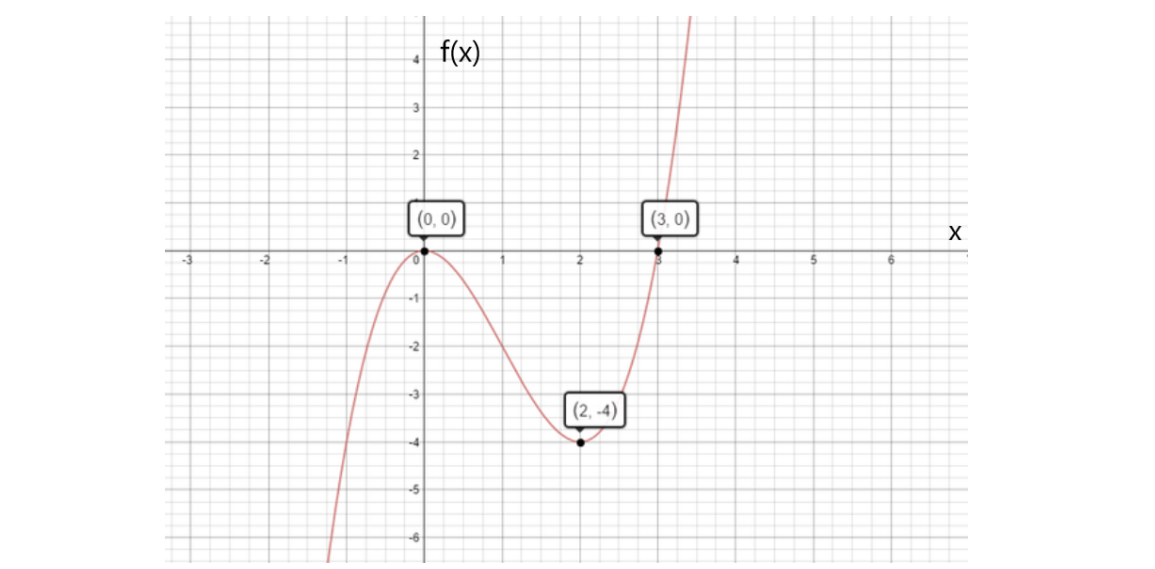
Observe the graph, it has turning points are (0,0) and (2,−4).
The x intercepts are at x=0, and x=3.
The function is at peak at the point (0,0) and at its lowest peak at (2,−4).
Therefore, (0,0) is local maxima and (2,−4) is the local minima.
The graph of the function is given below.
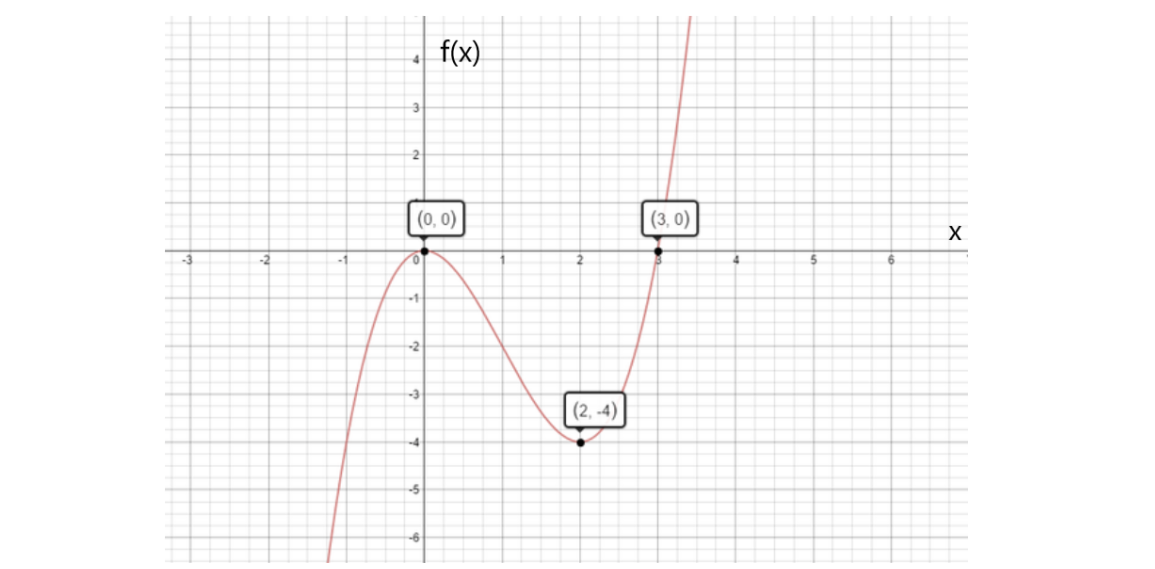
Number of turning points: 2 Turning points: (0,0) and (2,−4).
x-intercept: x=0,3
Local maxima: (0,0)
Local Minimum:(2,−4)
Page 267 Exercise 9, Answer
It is given thath(x)=(x−4)(x−3)(x+2)2.
It is required to graph the function using a graphing calculator and state the number of turning points, and the x- intercepts.
Use a graphing calculator, plot the function. Observe the turning points.
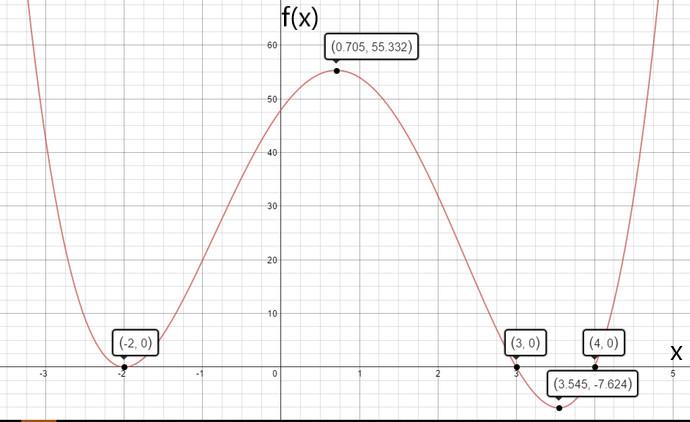
Given,h(x)=(x−4)(x−3)(x+2)2.
The graph is a Observe the graph, it has three turning points, that are, (−2,0), (0.705,55.332), and (3.545,−7.624).
The x-intercepts are at x=−2, and x=3, and x=4.
The function is at peak at the point (0.705,55.332) and at its lowest peak at two points, (−2,0) and (3.545,−7.624).
Therefore, (0.705,55.332) is local maxima and (−2,0), and (3.545,−7.624) is the local minima.
The graph of the function is given below.
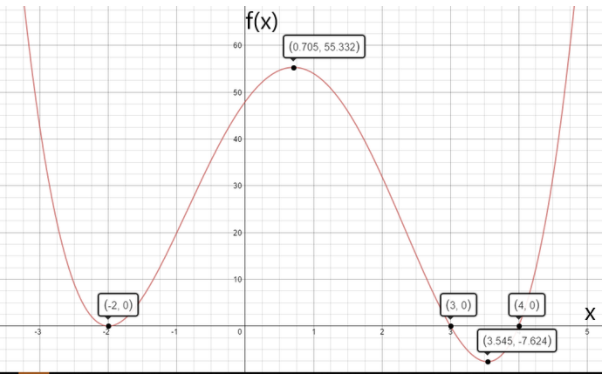
Number of turning points: 3
Turning points: (−2,0),(0.705,55.332), and (3.545,−7.624).
x-intercept: x=−2, 4, 3
Local maxima: (0.705,55.332)
Local Minimum: (−2,0) and (3.545,−7.624)
HMH Algebra 2 Chapter 5 Polynomial Functions Exercise 5.2 Solutions
HMH Algebra 2 Volume 1 1st Edition Module 5 Chapter 5 Exercise 5.2 Polynomial Functions Page 267 Exercise 10, Answer
It is required to give an example of a cubic function.The volume of a cube or cylinder is an example of a cubic function from the real world
Assume a cube with length, x, width x, and height x.
Then, its volume will be the product of all the side lengths.
Therefore, the volume will be x3, which is a cubic function.
Hence, the volume of a cube can be treated as an example of a cubic function from real world.
The volume of a sphere as a function of the radius of the sphere is a cubic function.
Similarly, the volume of a cube as a function of the length of one of its sides is a cubic function.
Page 268 Exercise 11, Answer
Three functions are given.
It is required to tell whether the vertex of the graph translated to the right and up when compared to f(x)=x3.
Check the transformations of y=(x+3)3+2.
Use a graphing calculator, and graph y=(x+3)3+2.
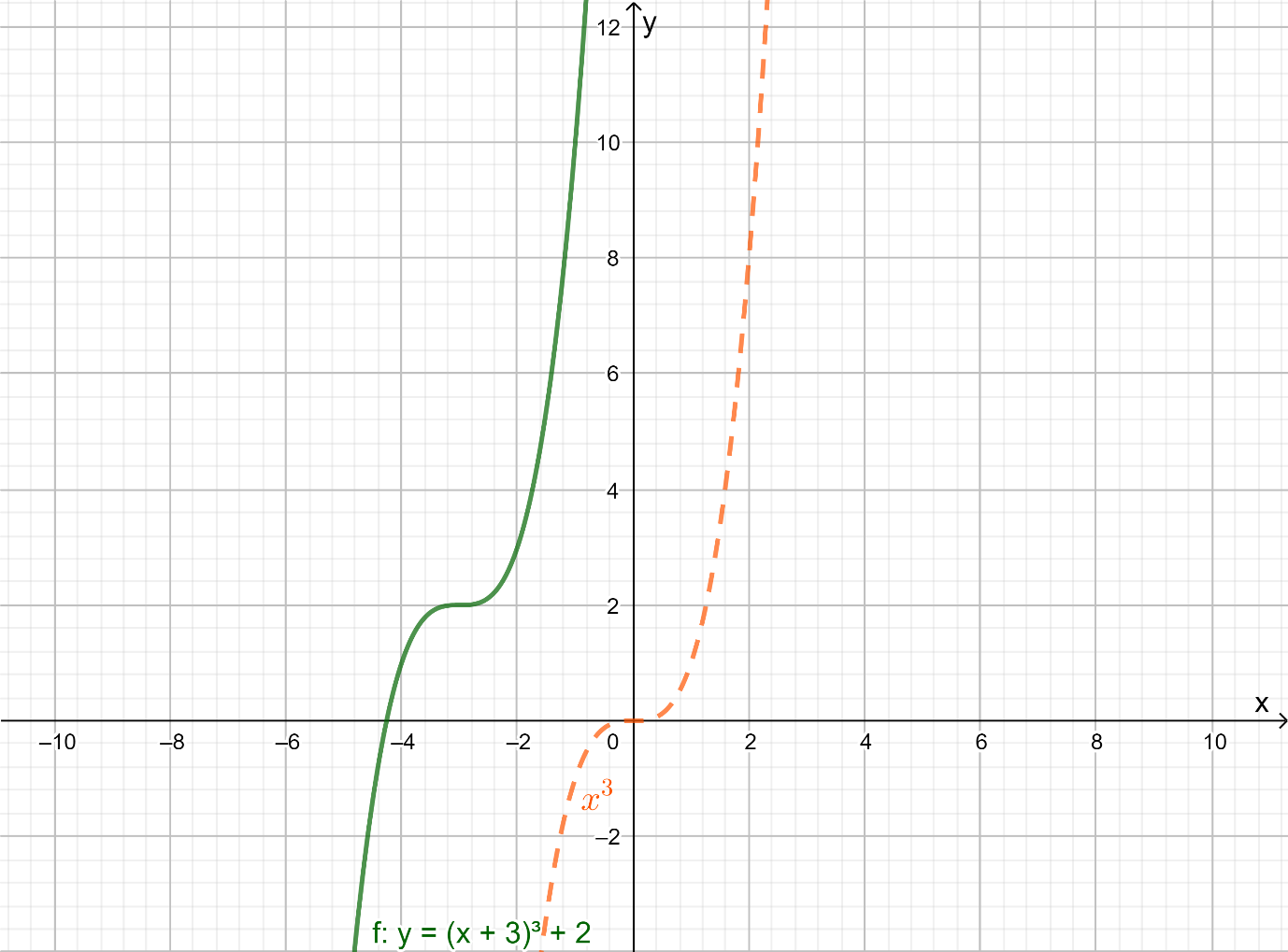
Observe that the vertex is translated left and up.
Check the transformations of y=5x3+7.
Use a graphing calculator, and graph y=5x3+7.
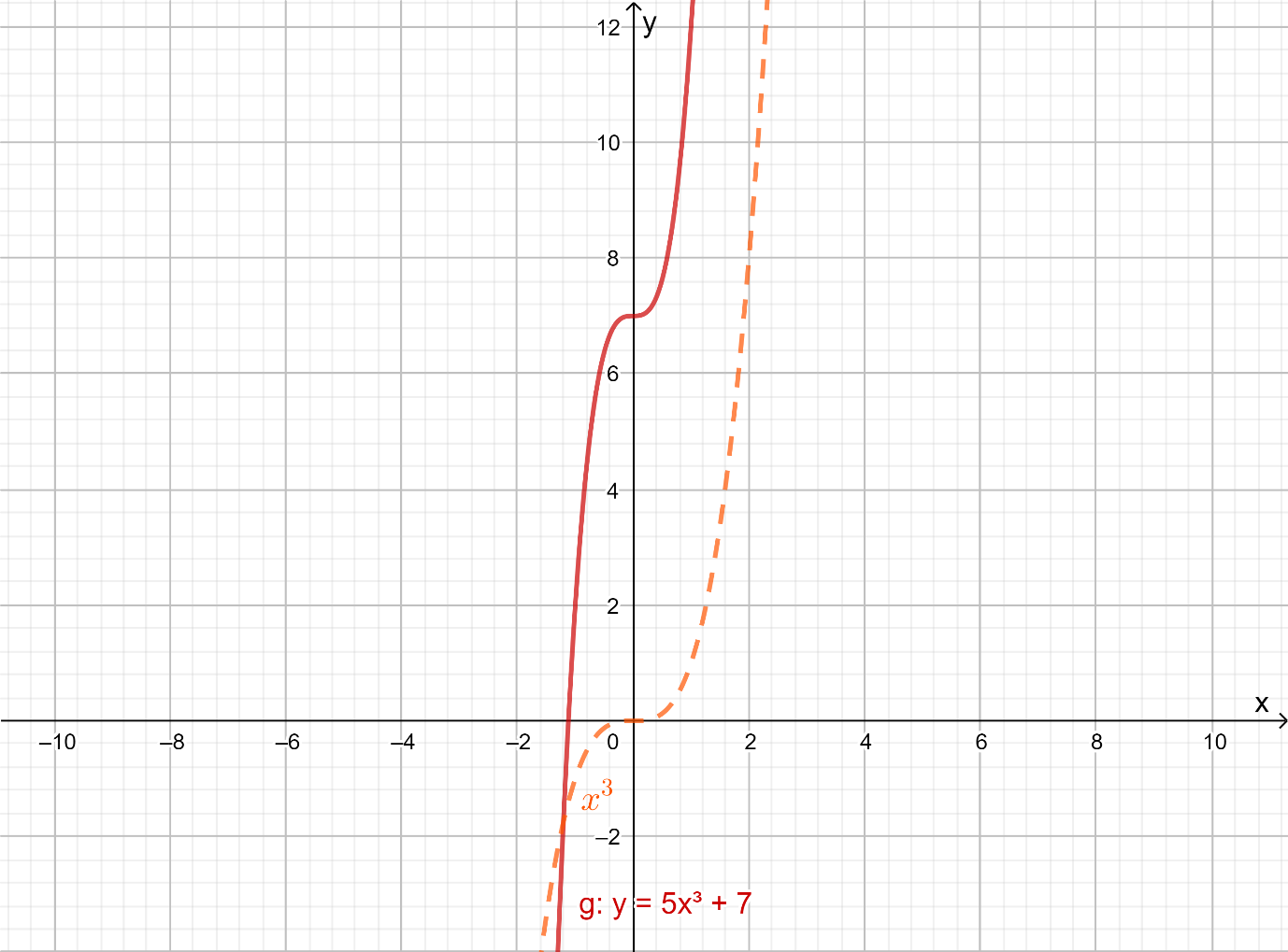
Observe that the vertex is translated up only.
Check the transformations of y=(x−4)3+2.
Use a graphing calculator, and graph y=(x−4)3+2.
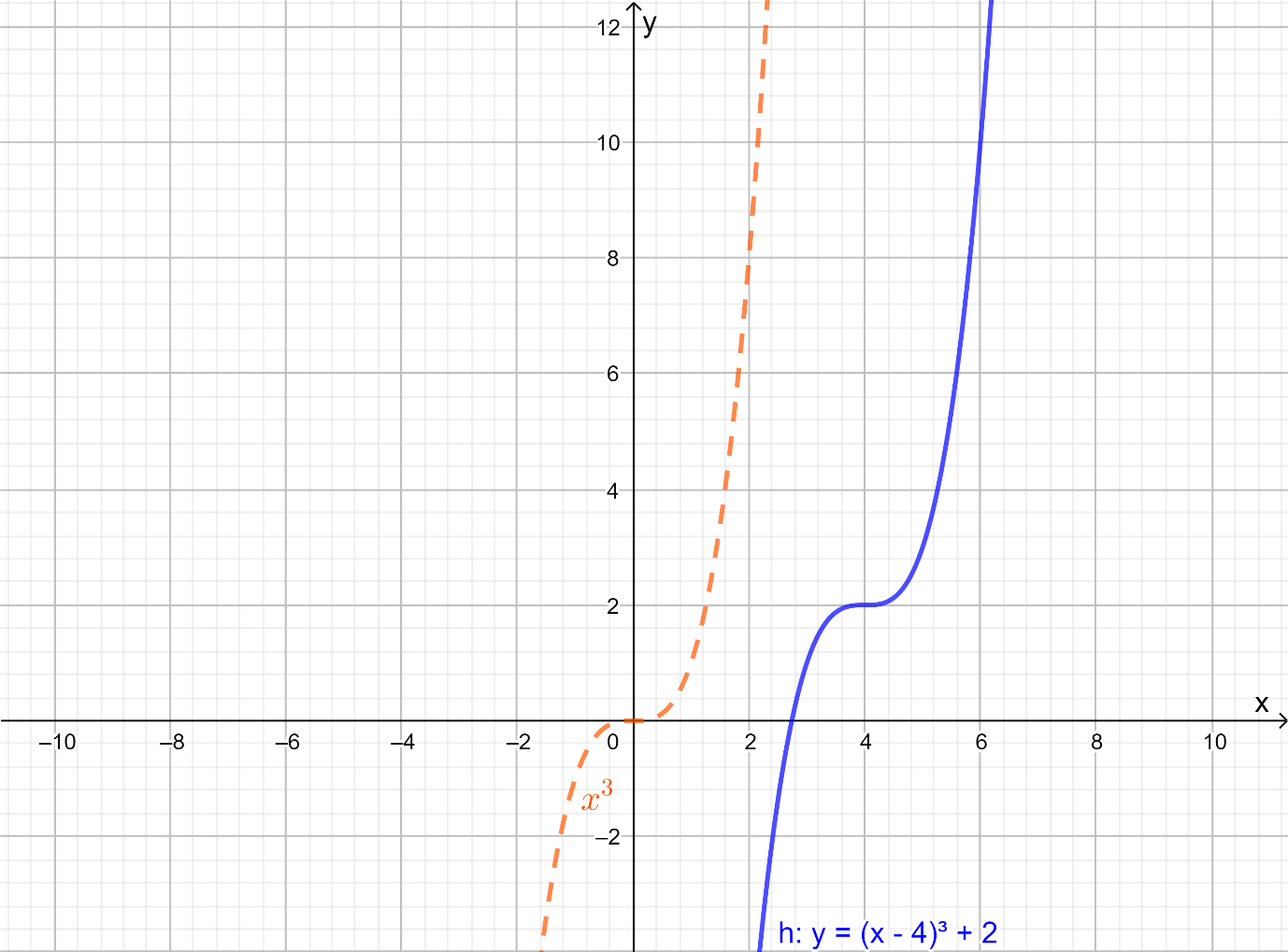
Observe that the vertex is translated four units to the right and 2 units up.
The following are the answers for the given polynomials:
y=(x+3)3+2:No y=5x3+7: No y=(x−4)3+2 : Yes
Page 268 Exercise 12, Answer
It is given that h(x)=x(x−1)(x+3)3.
It is required to find whether the given three sentences are true or false.
Make the graph of the given function using the graphing calculator. Now, observe the curve and answer the sentences.
Using a graphing calculator, plot the function.

The graph has three turning points. So, the statement the graph has four turning points is false.
Observe the graph, it crosses the x-axis at −3, 0, and 1.
The statement that the graph crosses the x-axis at −3, −1, 0, and 1 is not true.
A maximum or minimum is said to be global if it is the largest or smallest value of the function, respectively, on the entire domain of a function.
The domain of the given function is all real numbers.
From the graph, observe that it does not have any specific smallest value or any specific largest value with respect to the domain.
Therefore, there are no global maxima and minima.
The statement A and B are false and statement C is true.
HMH Algebra 2 Volume 1 1st Edition Module 5 Chapter 5 Exercise 5.2 Polynomial Functions Page 268 Exercise 13, Answer
It is given a graph of a polynomial that cuts the x-axis at 4 points.
It is required to find a quadratic function in intercept form for the given graph whose x-intercepts are integers assuming that the constant factor a is either 1 or −1.
First, identify the x intercept that means find out the points where the curve cut thexaxis, make them in factor form.
Then, write the polynomial as product of all the factors and assume the constant as 1 to get the function.
Analyse the given graph, where it cuts the xaxis. Therefore, it cuts the axis at x=−2,x=0,x=3, andx=5.
Let P(x) be the polynomial.
As x=−2 is a zero so, (x+2) is a factor.
As x=0 is a zero so, x is a factor.
As x=3 is a zero so, (x−3) is a factor.
As x=5 is a zero so, (x−4) is a factor.
The polynomial is factored form will be P(x)=ax(x+2)(x−3)(x−5).
Check the end behaviour of the polynomial.
The end behaviour of the polynomial is x→∞ then, P(x)→∞ and when x→−∞ then, P(x)→∞.
Therefore, a=1. Thus, P(x)=x(x+2)(x−3)(x−5) is the required function.
The quartic function in intercept form for the given graph isP(x)=x(x+2)(x−3)(x−5).
